

History Buffs
![]()
Below are two documents that will be of interest to history buffs.
The first is the a 3 page listing of 9th Infantry Division infantry battalions and their assignment to brigades; included are all assigned support units along with dates of deployment in Vietnam.
The second document is a 99 page assessment of NVA and VC unit deployment within South Vietnam, 1965 through 1972. Included are descriptions of tactics and weapons used by the NVA and VC. Many photos are presented within the document. For anyone interested in a detailed history of NVA and VC tactics and armament during the Vietnam war, this is a worthwhile read.
Thanks to Paul Kasper for forwarding these documents.
![]()
9th
Infantry Division
Activated 1 Feb 1966 for service in
Vietnam and sent there Dec 1966 – Jan 1967. The division served in III and
IV CTZ, and its 2nd Brigade was the Army component of the Mobile
Riverine Force. Division headquarters was at Bear Cat Dec 1966 – Jul 1968
and Dong Tam Aug 1968 – Aug 1969. The 9th Infantry Division began
withdrawing in summer 1969, leaving its 3rd Brigade behind as a
separate unit (under
* Remained as element of separate 3rd Brigade, 9th Infantry Division.
** Formed as element of separate 3rd Brigade, 9th Infantry Division.
Notes:
Gave
up mechanized equipment and converted to infantry Sep 1968
Coy
E/50th Infantry (LRP) inactivated 1 Feb 1969 and assets used to
form Coy E/75th Infantry (Ranger).
Remained
with the separate 3rd Brigade, 9th Infantry Division
until that unit left, then served as GHQ unit, moving to the I CTZ in the
north.
ARRIVALS and DEPARTURES by BRIGADE
1st Brigade, 9th Inf Div Jan 1967 – Aug 1969
2nd Brigade, 9th Inf Div Jan 1967 – Jul 1969
3rd Brigade, 9th Inf Div Dec 1966 – Oct 1970
The DS artillery battalions were shifted. 3rd/34th, for example, was initially in DS of 3rd Brigade, but then shifted to 2nd Brigade and the Riverine role. 2nd/4th was initially in DS of 2nd Brigade, but shifted to 3rd Brigade by the time it became a separate unit summer 1969. 1st/11th is also shown as having first served in DS of 2nd Brigade.
![]()

(1965 - 1975)
Summary of NVA and VC Units as of
March 1972
Generally this summary is limited to battalions or higher. Because the list is in that format, it is sometimes difficult to work back up to subordination of all units. An asterisk indicates a border area unit (i.e., along the border) but believed to be in South Vietnam at the time. Transportation and other service-type battalions have been omitted. "RR" indicates recoilless rifle, not railroad.
I CORPS TACTICAL ZONE
Military Region 5
· 1 VC Prod Thung Dung Bn, Quang Ngai
· 107 NVA Hvy Wpns Spt Bn, Quang Ngai
· 403 NVA Sapper Bn, Quang Ngai
· 406 NVA Sapper Bn, Quang Ngai
· 409 NVA Sapper Bn, Quang Ngai
· 120 VC Mont Inf Bn, Quang Ngai (Mont = Montagnard?)
· 402 NVA Sapper Bn, Quang Ngai
· 32 NVA Recon Bn, Quang Ngai
· 404 VC Sapper Bn, Quang Nam
· 471 VC Naval Sapper Bn, Quang Nam
42 NVA Military Station
· 3rd NVA Engr Bn, Thua Thien
· 4th NVA Engr Bn, Thua Thien
· 5th NVA Engr Bn, Thua Thien
· 6th NVA Engr Bn, Thua Thien
· K6 NVA Engr Bn, Thua Thien
Nong Truong 2 NVA Inf Division
· HQ Quang Tin
· *1 VC Inf Regt [40, 60, 90 VC Bns], Quang Tin
· 21 NVA Inf Regt [4th, 5th, 6th Bns], Quang Ngai
· 31 NVA Inf Regt [1st, 2nd, 3rd Bns], Quang Tin (note that NVA Regiment 31, with a different composition, is also shown listed under B-5 Front)
· 10 NVA Sapper Bn, Quang Tin
· 12 NVA Art Bn, Quang Tin
· GK40 NVA Engr Bn, Quang Tin
Front 4
· [HQ] Quang Nam
· 38 NVA Inf Regt [7th, 8th, 9th Bns], Quang Nam
· 141 NVA Inf Regt [1st, 2nd, 3rd Bns], Quang Nam
· 577 NVA RL Bn, Quang Nam
· R20 VC Inf Bn, Quang Nam
· T89 VC Sapper Bn, Quang Nam
· 42 VC Recon Bn, Quang Nam
· 91 NVA Sapper Bn, Quang Nam
· V25 VC Inf Bn, Quang Nam
· 575 NVA Rocket Bn, Quang Nam
· 8 NVA Sapper Bn, Quang Nam
Quang Da Province
· Q82 VC LF Inf Bn, Quang Nam
· Q80 VC LF Inf Bn, Quang Nam
· 9 NVA LF Inf Bn, Quang Nam
Quang Ngai Province
· 83 VC LF Inf Bn, Quang Ngai
· 48 VC LF Inf Bn, Quang Ngai
· 40 NVA LF Inf Bn, Quang Ngai
Quang Nam Province
· 70 VC LF Inf Bn, Quang Nam
· 72 VC LF Inf Bn, Quang Tin
· 74 VC LF Cmbt Spt Bn (Mortar), Quang Tin
· D11 NVA LF Inf Bn, Quang Nam
· 14 VC LF AA-AT Bn, Quang Tin
Military Region 6
· 840 VC Inf Bn, Binh Thuan
Binh Tran 42 NVA Mil Station
· 3rd , 4th, 5th, 6th, K6 NVA Engr Bns, Thua Thien
70B Corps
· [HQ] Quang Tri
· 304B NVA Inf Division HQ Quang Tr
o 9 NVA Inf Regt [1st, 2nd, 3rd Bns], Quang Tri
o 24B NVA Inf Regt [*4th, 5th, *6th Bns], Quang Tri
o 66B NVA Inf Regt [7th, 8th, 9th Bns], Quang Tri
o 20 NVA Sapper Bn, Quang Tri
B5 Front
· [HQ] Quang Tri
· 27 NVA Inf Regt [1st, 2nd, 3rd Bns], Quang Tri
· 31 NVA Inf Regt [15th, 27th Bns], Quang Tri (also has two VC inf and two NVA sapper coys)
· 270 NVA Inf Regt [4th, 5th, 6th Bns, 6th Air Def? Bn], Quang Tri
· 84 NVA Rocket Regt [1st, 2nd, 3rd, 4th RL Bns], Quang Tri
· 164 NVA Art Regt [1st, *2nd, 3rd Art Bns], Quang Tri
· 246 NVA Inf Regt[1st, 2nd, 3rd Bns], Quang Tri
· 38 NVA Art Regt [1st, 2nd, 3rd Art Bns], Quang Tri
· 33 Indep NVA Sapper Bn, Quang Tri
Tri Thien Hue Military Region
· [HQ] Thua Thien
· 4 NVA Inf Regt [K48 VC, K4C NVA Bns], Thua Thien
· 5 NVA Inf Regt [804, 810 NVA Inf, Chi Thua II VC Sapper, 32 NVA RL Bns], Thua Thien
· 6 NVA Inf Regt [800, 802, 806 NVA Inf, 12 NVA Sapper, 35 NVA RL Bns], Thua Thien
· K3 NVA Sapper Bn, Thua Thien
· K44 NVA Engr Bn, Thua Thien
· 11A NVA Recon Bn, Thua Thien
7th NVA Front
· [HQ] Quang Tri
· *324B NVA Inf Division HQ, Quang Tri
o 803 NVA Inf Regt [1st, 2nd, 3rd Bns], Thua Thien
o 29 NVA Inf Regt [7th, 8th, 9th Bns], Thua Thien
o 812 NVA Inf Regt [4th, 5th, 6th Bns], Quang Tri
Quang Tri Province
· K34 NVA Rocket Bn, Quang Tri
· 10 NVA Sapper Bn, Thua Thien
· 814 NVA Inf Bn, Quang Tri
· 808 NVA Inf Bn, Quang Tri
Thua Thien Province
· Phu Loc VC LF Inf Bn, Thua Thien
NVA Sapper Combat Group
· 126 Naval Sapper Regt, Quang Tri (battalion-sized?)
Quang Binh Province
· 49 NVA LF Inf Bn, Quang Tri
320 NVA Inf Division
· 52B NVA Inf Regt [HQ only], Quang Tri
[There were also 63 VC and 3 NVA companies in ARVN MR 1: 57 maneuver and 6 combat support VC, 2 maneuver and 1 combat support NVA.] - See Below*contains identified companies.
II CORPS TACTICAL ZONE
Military Region 5
· 407 VC Sapper Bn, Khanh Hoa
Nong Truong
· 3 NVA Inf Division
o HQ Binh Dinh
o 12 NVA Inf Regt [4th, 5th, 6th Bns]
o 2 NVA Inf Regt [1st, 2nd, 3rd Inf, 4th Sapper, 5th Art Bns], Binh Dinh
o 90 NVA Engr Bn, Binh Dinh
o 200 NVA Air Def Bn, Binh Dinh
Binh Dinh Province
· 50 VC LF Inf Bn, Binh Dinh
· E 210 VC LF Inf Bn, Binh Dinh
· 405 VC LF Sapper Bn, Binh Dinh
· 8 NVA LF Inf Bn, Binh Dinh
Khanh Hoa Province
· K12 NVA LF Inf Bn, Khanh Hoa
· Khanh Hoa VC LF Sapper Bn, Khanh Hoa
Phu Yen Province
· 96 VC LF Inf Bn, Phu Yen
· K13 NVA LF Inf Bn, Phu Yen
· K14 VC LF Sapper Bn, Phu Yen
· 9 NVA LF Inf Bn, Phu Yen
Military Region 6
· 130 NVA Art Bn, Binh Thuan
· A16 NVA Sapper Bn, Tuyen Duc
· 186 VC Inf Bn, Binh Thuan
· 240 NVA Inf Bn, Binh Thuan
Binh Thuan Province
· 481 VC LF Inf Bn, Binh Thuan
· 482 VC LF Inf Bn, Binh Thuan
Tuyen Duc Province
· 810 VC LF Inf Bn, Tuyen Duc
Military Region 10
Quang Duc Province
· D251 VC LF Inf Bn Quang Duc
B3 NVA Front
· [HQ] Kontum
· 24 NVA Inf Regt [4th, 5th, 6th Bns], Pleiku
· 66 NVA Inf Regt [*7th, 8th, *9th Bns], Kontum (from Cambodia)
· 95B NVA Inf Regt [K1, K63, K394 Bns], Pleiku
· 28 NVA Inf Regt [K1, K2, K3 Bns], Kontum
· 40 NVA Art Regt [K16, K33, K40 NVA Art, K32 NVA (120mm) Mortar, K30 NVA Air Def Bns], Kontum
· K25 NVA Engr Bn, Kontum
· K37 NVA Sapper Bn, Kontum
· *K20 NVA Sapper Bn, Kontum (from Cambodia)
· 631 NVA Inf Bn, Pleiku
· K28 NVA Recon Bn, Kontum
· K80 NVA Sapper Bn, Kontum
· K27 NVA Guard Bn, Kontum
Darlac Province
· E 301 VC LF Inf Bn, Darlac
· 401 VC LF Sapper Bn, Darlac
Kontum Province
· 304 VC LF Inf Bn, Kontum
· 406 VC LF Sapper Bn, Kontum
Gia Lai Province
· 408 VC LF Sapper Bn, Pleiku
· X67 VC LF Inf Bn, Pleiku
· K2 NVA LF Inf Bn, Binh Dinh
· 450 VC LF Sapper Bn, Binh Dinh
· X45 VC Inf Bn, Pleiku
[There were also 93 VC and 1 NVA companies in ARVN MR 2: 87 maneuver and 6 combat support VC, 1 maneuver NVA.]
III CORPS TACTICAL ZONE
COSVN
· [HQ] Tay Ninh
· [Forward HQ], Binh Duong
· 180 VC Security Regt [O1, *O2 VC Sec Bns], Tay Ninh
· 46 VC Recon Bn, Tay Ninh
· 190 VC Sec Guard Bn, Tay Ninh
· A66 VC Strat Recon Bn, Tay Ninh
69 VC Artillery Division
· [HQ] Tay Ninh
· 96 NVA Art Regt [K3 and K4 NVA , K5 VC Art Bns]; Binh Long (K3 and K5), Tay Ninh (HQ and K4)
· 208B NVA Rkt Regt (1, 2 NVA RL, 22 NVA Art Bns), Tay Ninh
· 56 VC Air Def Bn, Tay Ninh
· 58 VC Art Bn (Mortar), Tay Ninh
Cong Truong 5 VC Inf Division
· HQ Phuoc Long
· 275 VC Inf Regt [1st, 3rd Bns], Phuoc Long
· 174 NVA Inf Regt [1st, 2nd, 3rd Bns], Tay Ninh
· *6 VC Inf Regt [7th, *8th, *9th Bns], Binh Long
· 22 NVA Art Bn, Binh Long
· 24 NVA Air Def Bn, Binh Long
· *27 VC Recon Bn, Binh Long
· *28 VC Sapper Bn, Binh Long
Cong Truong 7 NVA Inf Division
· HQ Tay Ninh
· 141 NVA Inf Regt [1st, 2nd, 3rd Bns], Tay Ninh
· 165 NVA Inf Regt [1st, 2nd, 3rd Bns], Tay Ninh
· 209 NVA Inf Regt [K4, K5, K6 Bns], Tay Ninh
· K22 NVA Art Bn, Tay Ninh
· 24 NVA Air Def Bn, Tay Ninh (the duplication of the designation in CT 5 VC Inf Div is in the original document)
· 28 NVA Engr Bn, Tay Ninh
· 95 NVA Recon Sapper Bn, Tay Ninh
Cong Truong 9 VC Inf Division
· HQ Tay Ninh
· 271 VC Inf Regt [1st, *2nd, 3rd, 4th Bns], Tay Ninh
· *272 VC Inf Regt [1st, *2nd, *3rd Bns], Tay Ninh
· 95C NVA Inf Regt [4th, 5th, 6th Bns], Tay Ninh
· 22 VC Art Bn, Tay Ninh
· 24 VC Air Def Bn, Binh Long
· T28 VC Recon Bn, Tay Ninh
Tay Ninh Province
· D1 VC LF Inf Bn, Tay Ninh
· D14 VC LF Inf Bn, Tay Ninh
Ba Ria SR
· D2 VC Inf Bn, Bien Hoa
· 8 VC Swimmer Sapper Bn, Bien Hoa
· Doan 10 VC Sapper Bn, Bien Hoa
· D445 VC LF Inf Bn, Long Khanh
· 6 NVA Sapper Bn, Long Khanh
· 74 NVA Rkt Regt [1st, 2nd, 3rd RL Bns]: Bien Hoa (HQ, 1st and 2nd) and Long Khanh (3rd)
· 274 VC Inf Regt [1st, 2nd, 3rd Bns]: Bien Hoa (HQ and 3rd) and Long Khanh (1st and 2nd)
· 33 NVA Inf Regt [K1, K2, K3 Bns]: Phuoc Tuy (HQ and K3), Long Khanh (K1), Binh Tuy (K2)
Thu Bien SR
· 2 VC Inf Bn, Phuoc Long
· D1 VC Sapper Bn, Bien Hoa
· K1 VC Inf Bn, Binh Duong
· K2 NVA Inf Bn, Bien Hoa
· D2 VC Inf Bn, Long Khanh
· K4 VC Inf Bn, Binh Duong
Sub Region 1
· 101 NVA Inf Regt [1st, 2nd, 3rd Bns]: Binh Long (HQ), Binh Duong (1st), Hau Nghia (2nd), Tay Ninh (3rd)
· Gia Dinh 4 NVA Sapper Bn, Gia Dinh
· 268 VC Sapper Bn, Hau Nghia
· 89 VC Art Bn, Binh Duong
Long An Sub Region
· 6 VC Inf Bn, Long An
· 12 VC Sapper/Recon Bn, Hau Nghia
· 267 VC Inf Bn, Hau Nghia
· 1696 VC Inf Bn, Hau Nghia
· 211 NVA Sapper Bn, Long An
· 506 VC Inf Bn, Long An
· Dong Phu NVA Inf Bn, Long An
· An My NVA Inf Bn (shows grid reference, no place name)
· 520 VC Inf Bn (shows grid reference, no place name strength shown as 20)
Military Region 10
· G45 NVA Inf Bn, Phuoc Long
Binh Long Province
· 368 VC LF Inf Bn, Binh Long
Phuoc Long Province
· D168 VC LF Inf Bn, Phuoc Long
NT 1 NVA Inf Division
· 25 NVA Engr Bn, Tay Ninh
· 24 NVA AA Bn, Tay Ninh (another near duplicate designation in the original document, although this is shown as AA rather than AD)
Sapper Command
· [HQ] Nov 1965 Tay Ninh
· 7 NVA Sapper Bn, Tay Ninh
· 8 NVA Sapper Bn, Tay Ninh
· 9 NVA Sapper Bn, Binh Duong
· 10 NVA Sapper Bn, Tay Ninh
· (VC) *Recon Bn, Tay Ninh
· 13 NVA Sapper Bn, Binh Duong
· D16 NVA Sapper Bn, Tay Ninh
· D14 NVA Sapper Bn, unknown
[There were also 44 VC and 1 NVA companies in ARVN MR 3, all maneuver.]
IV CORPS TACTICAL ZONE
Sapper Command
Military Region 2
· 88 NVA Inf Regt [K7, K8, K9 Inf, K10 Sapper Bns]: Dinh Tuong (HQ, K1, K2), Kien Tuong (K9), Kien Phong (K10)
· DT1 VC Inf Regt [261A, 261B Inf, 269B Sapper Bns], Dinh Tuong
· *295 VC Inf Bn, Kien Phong
· Binh Duc VC Art Bn, Dinh Tuong
· 341 VC Sapper Bn, Dinh Tuong
· 267B VC Sapper Bn, Dinh Tuong
· 271 VC Inf Bn, Kien Tuong
An Gian Province
· *511 VC LF Inf Bn, Chau Doc
· 512 VC LF Inf Bn, Chau Doc
· 510 VC LF Inf Bn, Chau Doc
Ben Tre Province
· 516A VC LF Inf Bn, Kien Hoa
· 516B VC LF Inf Bn, Kien Hoa
· 516 VC LF Inf Bn, Kien Hoa
· 263 VC LF Inf Bn, Kien Hoa
Go Cong Province
· 514A VC LF Inf Bn, Go Cong
Kien Phong Province
· 502 VC LF Inf Bn, Kien Phong
Kien Tuong Province
· 504 VC LF Inf Bn, Kien Tuong
My Tho Province
· 514C VC LF Inf Bn, Dinh Tuong
· 207 VC LF Sapper Bn, Dinh Tuong
Military Region 3
· D1 VC Inf Regt [309th, 303rd Bns], Chuong Thien
· D2 VC Inf Regt [Z7th, Z8th, Z9th Inf, Z10th Sapper Bns]: Kien Giang (HQ, 29th, 210th), An Xuyen (27th), Chuong Thien (28th)
· D3 VC Inf Regt [306th, 312th Bns]: Vinh Binh (HQ and 306th), Vinh Long (312th)
· 95A NVA Inf Regt [27th, 28th, 29th NVA Inf 23rd VC Sapper Bns]: Kien Giang (HQ, 23rd), An Xuyen (27th—29th)
· 188 NVA Inf Regt [Z4, Z5, Z6 Inf, T28 Sapper Bns], Kien Giang
· 2311 VC Art Bn, Chuong Thien
· TN3173 VC Inf Bn, Kien Giang
· 301 VC Sapper/Engr Bn, Kien Giang
· 2315 VC Art Bn, An Xuyen
· 962 VC Inf Bn, An Xuyen
· 307 VC Inf Bn, Kien Giang
Ca Mau Province
· U Minh 2 VC LF Inf Bn, An Xuyen
Can Tho Province
· Tay Do I VC LF Inf Bn, Chuong Thien
· Tay Do II VC LF Inf Bn, Phong Dinh
Rach Gia Province
· U Minh 10 VC LF Inf Bn, Chuong Thien
Soc Trang Province
· D764 VC LF Inf Bn, Chuong Thien
Tra Vinh Province
· 501 VC LF Inf Bn, Vinh Binh
Vinh Long Province
· O857 VC LF Inf Bn, Kien Hoa
Phuoc Long Group
· 410 VC Inf Bn, Kien Giang
[There were also 107 VC companies in ARVN MR 4: 99 maneuver and 8 combat support.]
ATTACHMENT C. Identified Companies.
|
|
|
|
|
All of these are VC unless explicitly labeled NVA. Mar 1972 location province is shown after the unit in two cases: the unit is not subordinated to a province, or it is shown located in a province other than that implied by its subordination to a province or district.
I CORPS TACTICAL ZONE
7th Military District
Front 4
Quang Tri Province
Thua Thien Province
Quang Da Province
Quang Ngai Province
Quang Nan Province
II CORPS TACTICAL ZONE
Military Region 6
B3 Front
Ninh Thuan Province
Lam Dong Province
Binh Thuan Province
Tuyen Duc Province
Darlak Province
Kontum Province
Gia Lai Province
Binh Dinh Province
Khanh Hoa Province
Phu Yen Province
III CORPS TACTICAL ZONE
Tay Ninh Province
Ba Ria Special Region
Thu Bien Special Region
Sub Region 1
Long An Subregion
Phuoc Long Province
Binh Tuy Province
IV CORPS TACTICAL ZONE
Military Region 2
An Giang Province
Ben Tre Province
Go Cong Province
Kien Phong Province
Kien Tuong Province
My Tho Province
Ca Mau Province
Can Tho Province
Rach Gia Province
Soc Trang Province
Tra Vinh Province
Vinh Long Province

NVA & VC Base Camps
GENERAL
Fortified base camps were the pivots of Viet Cong (VC) military operations and, it was believed, if denied their use, the VC movement would wither. Local force units tended to place reliance on numerous small base camps dispersed throughout their area of operations and each unit attempted to maintain at least one elaborately fortified refuge. The larger local force units normally constructed a tunnel complex which housed their hospital and headquarters. The camps were usually extensively booby trapped and protected by punji stakes, mines and spike traps. Main Force base camps, on the other hand, were usually not so well guarded by mines; they were however, larger and frequently included training facilities, such as rifle ranges and classrooms. Main Force units invariably had pre-stocked base camps throughout their area of operations and often shifted their forces as the tactical situation dictated, either for offensive or defensive reasons.
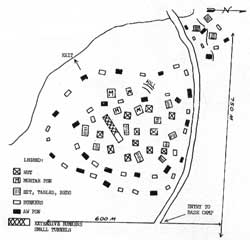
Figure 1
Years of labor and an immense amount of material went into building a complex network of base camps throughout the country. It was this network which sustained irregular operations. A semi-guerrilla army, such as that of the VC, could no more survive without its base camps than a conventional army could survive when cut off from its main bases. However remote and concealed, the base camps could not be easily moved or hidden indefinitely. To find and destroy these camps was a prime objective of the allied military effort.
Defended base camps presented a formidable obstacle to the attacker. They were normally somewhat circular in form with an outer rim of bunkers, automatic weapons firing positions, alarm systems and foxholes. Within the circle there was a complete system of command bunkers, kitchens and living quarters constructed above the ground from a wide variety of materials. (Figs. 1, 2 and 3 illustrate the various types of VC base camps which were encountered by tactical units in South Vietnam).
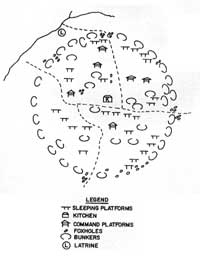
Figure 2
The exact shape of the camp varied in order to take maximum advantage of natural terrain features for protection and to restrict attack on the camp to one or two avenues. Some of the camps, particularly those used only for training or way stations, had minimum defensive works. However, in all cases, the enemy was prepared to defend his camp against a ground attack. Even though natural terrain features may have caused a given camp to resemble a cul-de-sac there was at least one prepared exit or escape route opposite the anticipated direction(s) of attack. Tunnels connected the bunkers and firing positions, enabling the defenders to move from one point to another. This technique enhanced the effect of their firepower and gave them a significant advantage over the attacker. An unfordable river often paralleled one flank of a typical camp while open paddy land bordered the other.
The apparent lack of escape routes made the position appear like an ideal target for ground attack. However, until bombardment had removed most of the foliage, any maneuver into these areas on the ground was a complex problem. One local force squad had been known to withstand the assault of two US Army infantry companies, and a VC sniper or two, firing from within a mined camp, could inflict numerous casualties on the attacking force.
LOCATION AND DETECTION OF BASE CAMPS
The 1st Brigade, 101st Airborne Division (US), made a study to determine if patterns existed for the establishment of enemy base camps and defensive fortifications. It was found early in the operation that the enemy invariably established his bases in the upper reaches of draws where water was available and dense foliage precluded aerial observation. Fortifications were found on the "fingers" covering the base camps and were mutually supporting. A comparison with information obtained from other sources such as agent reports, trail studies, etc., indicated that a pattern did exist and that potential base areas and bunkered positions could be predicted with reasonable accuracy. Based on this finding, information obtained from the Combined Intelligence Center, Vietnam (CICV), photos, Red Haze, visual reconnaissance and special agent reports was placed on overlays and the density of activity plotted. The plot was then transferred to maps using the color red to represent probable base camp locations. A careful study of surrounding terrain was then made to determine likely defensive positions and these were entered in blue on the map. Thus, commanders were presented with a clear indication of the most likely areas which would be defended. This method of identifying probable base camps and defensive positions proved to be relatively accurate.
During OPERATION MAKALAPA, the 25th Infantry Division (US) found that VC base camps were normally located along streams and canals and that extensive bunker complexes were built into the banks. Bunkers were usually constructed of a combination of mud, logs and cement. The bunkers presented a low silhouette and had extensive lanes of fire along the main avenue(s) of approach. Excellent camouflage negated the effectiveness of allied aerial and ground observation.
In OPERATION WHEELER, the 1st Brigade, 101st Airborne Division (US) found that "People Sniffer" missions effectively produced intelligence in areas of heavy vegetation where visual reconnaissance was ineffective. These missions were also invaluable in verifying agent reports as well as specifically locating enemy units, hospitals or storage areas as revealed by detainees or captured documents.
The After Action Report of the 25th Infantry Division (US) for OPERATION JUNCTION CITY, reflected that of the sixteen base camps discovered, two wore considered to be regimental size, ten battalion size and four company size or smaller. All base camps were located 200 meters or closer to a stream or other source of water. Each camp was encircled by a bunker system with interconnecting trench systems. The defensive positions showed evidence of careful planning of fields of fire and were well camouflaged and expertly organized. Enemy claymore mine positions were marked on the enemy side of a tree, usually with a single strip of white cloth or an "X"' cut into the tree.
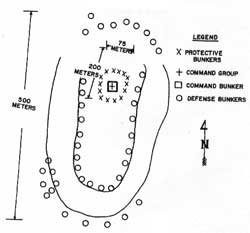
Figure 3
The 3rd Brigade, 1st Infantry Division (US) reported, after the completion of OPERATION JUNCTION CITY, that most base camps were located near streams or roads. It appeared that the plan was to locate all installations close to transportation routes. This Brigade made the same comment in their After Action Report for OPERATION BATTLE CREEK.
The 3rd Battalion, 22nd Infantry, 4th Division (US) After Action Report for OPERATION BREMERTON, which was conducted in the Rung Sat Special Zone, reflected that the most likely base camps in that area existed on the high ground. Therefore, caution had to be exercised when entering dry ground from the swamps. Also, all base camps encountered were within 150 meters of some type of waterway. Further, these camps, without exception, were well concealed and effectively bunkered. Similarity of these base camps enabled units to plan their method of approach to minimize friendly casualties.
In the conduct of OPERATION BENTON by the 196th Light Infantry Brigade (US), it was noted that in almost all cases the enemy installations were within 1000 meters of a valley or actually in the valley. This indicated that in this area, the VC avoided the rugged and more formidable higher elevations.
The 1st Brigade, 101st Airborne Division (US) found in OPERATION HOOD RIVER, that the VC continued to utilize mutually supporting draws, each characterized by a water supply, dense foliage and fortified positions guarding accesses to base camp areas. This same unit noted in their After Action Report for OPERATION BENTON that the VC guarded his base camps with local forces who wore well trained and very capable of executing all aspects of guerrilla warfare.
Following OPERATION YELLOWSTONE, the 3rd Squadron, 17th Cavalry (-) (US) reported that sightings of previously unlocated base camps were reported daily. As each sub-area was searched in detail, large bunker complexes were located along every large stream in the jungle area. Enemy lines of communication interlacing the fortified base camps were found and plotted. Many of the base camps were vacant but a large percentage proved to be occupied and well defended.
The After Action Report of the 1st Brigade, 25th Infantry Division (US) for OPERATION LANIKAI reflected that during this operation VC base camps were normally found along stream beds adjacent to built-up areas or in the midst of occupied villages. Bunkers were found in most homes, astride or strung along roads and dikes and in the corners of hedge rows. Pagodas were normally VC meeting places and were often protected by bunker complexes.
The use of the "Open Arms" program to obtain intelligence of specific areas and for guides to areas could be very effective. During OPERATION DAN TAM 81, conducted by the 11th Armored Cavalry Regiment, the exact locations of VC base camps were revealed by a Hoi Chanh.
The 1st Battalion, 18th Infantry, 1st Infantry Division (US) reported upon completion of OPERATION BATON ROUGE that whenever a unit moved into an area where there were indications that much wood had been cut, the unit expected to find a base camp within 200 to 500 meters of the cutting area. (Note: VC regulations prescribed that wood cutting must be done at least one hour's walking time from such facilities.) Upon completion of OPERATION LEXINGTON III, this same unit reported that base camps and facilities were generally found near streams, indicating the need for easy accessibility in the type of terrain encountered in the area.
During OPERATIONS MANCHESTER, UNIONTOWN/STRIKE and UNIONTOWN I, the 199th Brigades 503rd Chemical Detachment conducted twelve "People Sniffer" missions during the period 17 December 1967 to 13 January 1968, identifying 94 hot spots of probable enemy activities. The "People Sniffers" enjoyed several successes by identifying VC base camps and supplementing other intelligence means in locating areas of enemy activity.
The After Action Report of the 199th Light Infantry Brigade for OPERATIONS MANCHESTER, UNIONTOWN/STRIKE and UNIONTOWN I contained the comment that the humane and considerate treatment of Hoi Chanhs reaped high dividends, saving countless man-hours of operational time. Once the confidence of these returnees was gained and sincere concern for their well being was established, they willingly provided information leading to identification and destruction of Viet Cong forces or their base camps.
For a long time it was thought that because of their superior knowledge of these areas, the Viet Cong habitually established base areas deep in the interior. Operations conducted by the 1st Brigade, 101st Airborne Division tended to disprove this belief. Apparently the Viet Cong did not regularly inhabit the interior of dense jungle areas unless they were accessible by trail. Instead, they operated from bases within two or three kilometers of the jungle periphery.
Upon completion of OPERATION JUNCTION CITY, the 196th Light Infantry Brigade reported that defoliation flights cleared away brush and effectively revealed the enemy's base camps and supply routes.
The 5th Special Forces Group (Airborne) reported that the questions most frequently asked local VC PWs and ralliers, especially Hoi Chanhs, pertained to the location of their base camps and AOs. The 5th SFG found that the two frequently used methods of map study and aerial observation were unsuccessful. Most PWs and Hoi Chanhs did not know direction, could not read a map and, when they were taken aloft for Visual Reconnaissance (VR), it was usually their first flight so they could not associate what they saw from the air with what they saw on the ground. However, most of these people would not admit that they were unable to read a map, tell direction or do a terrain analysis from the air. As a consequence, they usually replied in the affirmative when questions were asked. When detainees were re-interrogated using the same techniques, the information received in the second interrogation frequently differed from the first interrogation. One method of interrogation which proved successful was based on direct terrain orientation questions by the interrogator. First the detainee was asked the direction of the sun when he last left the base camp. He was then asked how long it took him to walk to the point where he Chieu Hoi'd or was captured. Judging from the type of terrain and health of the detainee the distance to the camp could generally be determined. The subject was then asked to enumerate significant terrain features he saw on each day of his journey, i.e., open areas, rubber lots, hills, rice paddies, swamps, etc. As the subject spoke and his memory was jogged, the interrogator found these terrain features on a current map and gradually plotted the subject's route and finally identified the area in which the base camp was located.
METHODS OF DESTROYING OR RENDERING BASE CAMPS UNTENABLE
The 1st Australian Task Force used tactical airstrikes, immediate and preplanned, against occupied enemy base camps during OPERATION INGHAM. Assessment of damage revealed that one strike was on target and destroyed two underground rooms, collapsed 60 yards of tunnel and blew in several weapons pits. One strike was not assessed as the camp was not revisited. The Task Force also reported that airstrikes were directed against the camps to force the enemy out of occupied camps during OPERATION PADDINGTON.
The 1st Brigade, 101st Airborne Division's method of rendering base camps untenable, as reported in their After Action Report for OPERATION MALHEUR, was to contaminate them from the air using CS. The CS concentration remained effective for a period of from four to six weeks.
During OPERATION DALLAS, the 2/2 Infantry (Mech) conducted jungle clearing operations in the Vinh Loi Woods with tank dozers and Rome Plows. During jungle clearing, when contact was made which indicated the presence of a VC base camp, the mechanized elements developed the situation by deploying laterally while directing supporting air and artillery fires into the suspected base camp. The jungle clearing vehicles immediately began clearing a swath completely around the base camp. When the circle was completed, additional swaths were progressively cleared into the center of the camp. The configuration of the cleared jungle took on the appearance of a spoked wheel superimposed on the base camp. After occupation and security of the base camp by mechanized elements, the camp would be systematically destroyed by dozers. The 2nd Brigade, 1st Infantry Division also reported the use of both Rome Plows and demolitions to destroy enemy base camps during this same operation.
The 4th Infantry Division utilized tactical air to destroy bunkers during OPERATION FRANCIS MARION. Battle damage assessment (BDA) indicated two bunkers destroyed and one or two bunkers damaged severely, depending upon point of impact. Eight-inch artillery did not affect the bunkers unless there was a direct hit and then only the bunker receiving a direct hit was destroyed. The 3rd Brigade, 4th Infantry Division reported after OPERATION NISQUALLY that enemy base camps were destroyed by burning but that during the dry season caution had to be exercised to prevent the fire from spreading to the adjacent jungle.
The 1st Infantry Division's tactic for destroying VC base camps during OPERATION TUCSON was that of backing off, destroying them with air and artillery, and then sweeping through the base camp with troops. During OPERATION CEDAR FALLS, this same division found that a dozer team of two tank dozers and six bulldozers was very effective, particularly when working in a joint effort with infantry. The infantry provided the security and the dozers destroyed the base camps and fortifications.
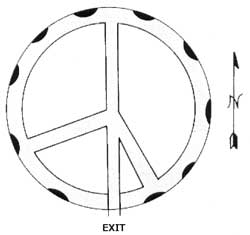
Figure 4: Base camp circular bunker
During OPERATION ATTLEBORO, elements of the 2nd Brigade, 1st Infantry Division discovered nine base camps, all of which had the same type fortifications. These ranged from open trenches and foxholes to bunkers with overhead cover. The largest base camp had fifty bunkers with overhead cover. Overhead cover consisted of logs with a layer of dirt. Destruction was difficult. At times units would physically remove the overhead cover and fill in the holes. The most elaborate was a circular bunker (See Fig 4). The bunker was 50 meters in diameter and the trench was 5 feet deep and 2 feet wide. 10 dugout holes in the trench were large enough for one man's protection against artillery. 6 claymores were wired and in the trench ready for ground emplacement. Control to fire the claymores was located at the southern exit. When demolitions were available they were used to destroy the bunkers. The primary means, however, of destroying the enemy installations was to call for air and artillery after evacuating the area.
SUMMARY OF SALIENT LESSONS LEARNED WITH RESPECT TO VC BASE CAMPS.

Allied Operations Against Tunnel Complexes
The use of tunnels by the VC as hiding places, caches for food and weapons, headquarter complexes and protection against air strikes and artillery fire was a characteristic of the Vietnam war. The 'fortified village', usually underlaid by an extensive tunnel system containing conference, storage and hiding rooms as well as interconnected fighting points had also been frequently encountered. However, as operations progressed into the war zones subsequent to January 1966, an even more extensive type of tunnel complex had begun to be encountered which combined underground security of personnel and supplies with an integrated, tactically located defensive system of fighting bunkers.
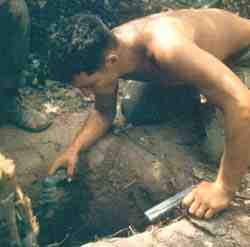
US tunnel rat prepares to enter
enemy tunnel system
The tunnel/bunker complexes encountered in the war zones were obviously the result of many years of labour, some in all probability having been initiated as early as WWII, with extension and improvement continuing throughout the war against the French and up until the time of their discovery by the US troops. These complexes presented a formidable and dangerous obstacle to operations that had to be dealt with in a systematic, careful and professional manner. Additionally, they were an outstanding source of intelligence, as evidenced by the several tons of documents found during the clearing of the Saigon-Cholon-Gia Dinh headquarters complex in Operation Crimp, January 1966.
Tunnel Characteristics
The first characteristic of a tunnel complex is normally superb camouflage.
Entrances and exits are concealed, bunkers are camouflaged and even within the
tunnel complex itself, side tunnels are concealed, hidden trapdoors are
prevalent, and dead-end tunnels are utilised to confuse the attacker. In many
instances the first indication of a tunnel complex was fire received from a
concealed bunker that might otherwise have gone undetected. Spoil from the
tunnel system was normally distributed over a wide area.
Trapdoors were utilised extensively, both at entrances and exits and inside the tunnel complex itself, concealing side tunnels and intermediate sections of the main tunnel. In many cases a trapdoor would lead to a short change-of-direction or change-of-level tunnel, followed by a second trapdoor, a second change-of-direction and a third trapdoor opening again into the main tunnel.
Trapdoors were of several types; concrete covered by dirt, hard packed dirt reinforced by wire, or a 'basin' type consisting of a frame filled with dirt. This latter type was particularly difficult to locate in that probing would not reveal the presence of the trapdoor unless the outer frame was actually struck by the probe. Trapdoors covering entrances were generally a minimum of 100 meters apart. Booby traps were used extensively, both inside and outside entrance and exit trapdoors. Grenades were frequently placed in trees adjacent to the exit, with an activation wire to be pulled by a person underneath the trapdoor or by movement of the trapdoor itself. Typical trapdoor configurations are shown below;
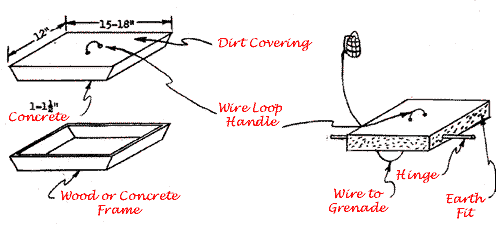
Tunnel complexes found in the War Zones were generally more extensive and better constructed than those found in other areas. In some cases these complexes were multileveled, with storage and hiding rooms generally found on the lower levels. Entrance was often gained through concealed trapdoors and secondary tunnels. In the deeper complexes, foxholes were dug at intervals to provide water drainage. These were sometimes booby-trapped as well as containing punji-stakes for the unwary attacker.
Although no two tunnel systems were exactly alike, a complex searched by 1st Battalion, RAR, during Operation Crimp may serve as a good example. The complex had the following characteristics;
Another tunnel characteristic of note was the use of air or water locks that acted as 'firewalls', preventing blast, fragments or gas from passing from one section of the tunnel complex to another. Use of these 'firewalls' is illustrated below;
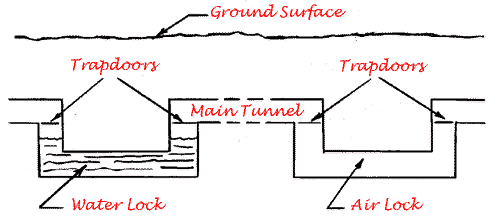
Recognition of their cellular nature was important for understanding these tunnel complexes. Prisoner interrogation indicated that many tunnel complexes were interconnected, but the interconnecting tunnels, concealed by trapdoors or blocked by 3 to 4-feet of dirt, were known only to selected persons and were used only in emergencies. Indications also pointed to interconnections of some length, e.g. 5 to 7-kilometers, through which relatively large bodies of men could be transferred from one area to another, especially from one 'fighting' complex to another.
The 'fighting' complexes terminated in well-constructed bunkers, in many cases covering likely landing zones in a war zone or base area. Bunker construction is illustrated below with examples uncovered by 1st Battalion, 503rd Airborne, during Operation Crimp;
|
|
|
Bunker raised three feet with four firing ports |
|
|
|
Bunker raised approximately one foot with one firing port |
|
|
|
Command Bunker |
Integration of these bunkers into a 'fighting' position is illustrated by the following diagram apparently used as a guide for VC construction in the CRIMP area;
|
|
The following experience of the 1st Infantry Division in the Di An and Cu Chi area is representative of tunnel operations; Tunnel Exploitation and Destruction · The area in the immediate vicinity of the tunnel was secured and defended by a 360-degree perimeter to protect the tunnel team · The entrance to the tunnel was carefully examined for mines and booby traps · Two members of the team entered the tunnel with wire communications to the surface · The team worked it's way through the tunnel, probing with bayonets for booby traps and mines and looking for hidden entrances, food and arms caches, water locks and air vents · As the team moved through the tunnel, compass headings and distances traversed were called to the surface where a team member mapped the tunnel · Captured arms and food items were turned over to the unit employing the team |
As other entrances were discovered and plotted, they were marked in such a way as to indicate if the VC used them after discovery, but before destruction could be accomplished. In many cases tunnels were too extensive to be exploited and destroyed in the same day and the VC mined entrances and approaches during the night after the tunnel team departed.
Upon completion of exploitation, forty pound cratering charges were placed fifteen to twenty meters from all known tunnel entrances and, where extensive tunnel complexes existed, ten pound bags of CS-1 Riot Control Agent were placed at intervals down the tunnel at sharp turns and intersections and tied into the main charge. Where sufficient detonating cord was not on hand to tie-in all bags of CS-1 to the main charge, bags of CS-1 were dispersed in the tunnel by detonation with a defused M-26 fragmentation grenade fused with a non-electric cap and a length of time fuse. Sharp turns in the tunnel protected the demolitions man from the grenade blast, if the detonation occurred before he exited the tunnel.
Tunnel Flushing and Denial
The infantryman discovering a spider hole or tunnel entrance during intensive
combat lobs an M-25 CS 'baseball type' grenade in the hole, followed by a
fragmentation grenade. The bursting of the CS gas grenade places an
instantaneous cloud of CS in the tunnel and the fragmentation grenade blows the
CS through a section of the tunnel while killing any VC near the entrance.
The low level contamination resulting from this method would serve only to discourage rather than prevent future VC use of that tunnel entrance.
Hasty Tunnel Flushing and Denial
In some areas the combat situation would permit a hasty search for hidden tunnel entrances but either lack of time or VC occupation of the tunnel would not permit exploitation by the tunnel team as described above (Tunnel Exploitation and Destruction).
In this case the Mity Mite Portable Blower could be employed to flush the VC from the tunnels burning CS Riot Control Agent grenades (M-7A2). In addition, the smoke from the grenades would, in most cases, assist in locating hidden entrances and air vents.
After flushing with CS grenades, powdered CS-1 could be blown into tunnel entrances to deny the tunnel to the VC for limited periods of time. In either case, these methods were only effective up to the first 'firewall' in the tunnel.
Representative Equipment List;
Protective mask; TA-1 telephone; one half mile field wire on 'doughnut' roll; compass (x2); sealed beam 12-volt flashlight (x2); small caliber pistol (x2); probing rods (12-inch and 36-inch); bayonet (x2); M7A2 CS grenades (x12); powdered CS (as required); coloured smoke grenades (x4); insect repellent and spray (4 cans); entrenching tool.
Small caliber pistols or pistols with silencers were the weapons of choice in tunnels, since larger caliber weapons without silencers had been known to collapse sections of the tunnel when fired and/or damage eardrums.
Careful mapping of the tunnel complex often revealed other hidden entrances as well as the location of adjacent tunnel complexes and underground defensive systems. Constant communication between the tunnel team and the surface was thus essential to facilitate tunnel mapping and exploitation.
Colored smoke grenades were often used to mark the location of additional entrances as they were found. In the dense jungle it was often difficult to locate the position of these entrances without smoke.
Dangers
Dangers inherent in the above operations fell into the following categories and had to be taken into account by all personnel connected with these operations;
· Mines and booby traps in the tunnel entrance/exit area
· Punji pits inside entrances
· Presence of small but dangerous concentrations of carbon monoxide, produced by burning-type smoke grenades after tunnels were smoked. Protective masks would prevent inhalation of smoke particles, which were dangerous only in very high concentrations, but would not protect against carbon monoxide
· Possible shortage of oxygen as in any confined or poorly ventilated space
· VC still in the tunnel who posed a danger to friendly personnel both above and below ground
Conclusions
A trained tunnel exploitation and denial team was essential to the expeditious and thorough exploitation and denial of VC tunnels since untrained personnel may have missed hidden tunnel entrances and caches, taken unnecessary casualties from concealed mines and booby traps and may not have adequately denied the tunnel to future VC use. To facilitate this, teams were trained, equipped and maintained in a ready status to provide immediate assistance when tunnels were discovered.
Tunnels were frequently found to be outstanding sources of intelligence and would therefore be exploited to the maximum extent possible. However, since tunnel complexes were carefully concealed, often extensive, and well camouflaged, search and destroy operations had to provide adequate time for a thorough search of the area to locate all tunnels. Complete exploitation and destruction of tunnel complexes was very time consuming and operational plans had to be made accordingly in order to ensure success.
The presence of a tunnel complex within or near an area of operations posed a continuing threat to all personnel in the area and no area containing tunnel complexes could ever be considered completely cleared.


NVA & VC Supply Caches
GENERAL
The combat experience of allied forces confirmed that supply caches were the lifeblood of the enemy's offensives. Without them, the Viet Cong's (VC) capability to sustain operations was seriously impaired. Cache destruction had an adverse affect upon the morale of the enemy individuals and units, and had a significant military impact on his operational plans and logistical support. Loss of medical supplies further compounded the VC's problem of maintaining unit effectiveness and conducting propaganda and recruitment operations.
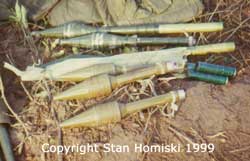
RPG's from captured enemy cache
A Combined Intelligence Center, Vietnam (CICV) Study (ST 68-09, Logistics Fact Book), dated 14 April 1968, stated that the enemy used an intricate system of caches and depots from which supplies were distributed to their units. In the past, the enemy had used large central caches at locations which provided quick and easy access to units in the field. As allied operations uncovered and destroyed these large depots and caches, the enemy found it necessary to disperse them. The VC began to store rice in homes of private citizens, but there were still instances when they maintained large central depots. Most caches served as temporary consolidation points for out-of-country supplies coming into SVN for distribution to units. It also appeared that highly accurate records were maintained of the supplies in the caches but there was normally little reference to cache locations.
Caches varied in size as to their content, and the unit or operation they supported. One example of a VC directive on construction of storehouses (caches) and the maintenance of supplies and facilities, as published by Doan 84 (Group 84), Rear Service Unit, SVN Liberation Army Headquarters, is at Appendix 1(below). (The document was found in a hut by K/3/11th Armored Cavalry Regiment and translated by the Combined Document Exploitation Center, J2, MACV.) Caches were usually well concealed or camouflaged and search operations had to be thorough and methodical.
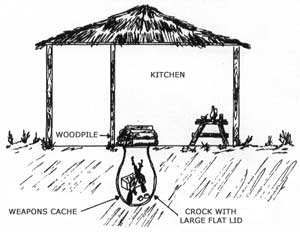
Pottery Weapons Cache
Emphasis was placed on evacuation of rice and other food caches for use by the GVN since evacuation of captured food caches served two important purposes. First, it denied the VC a much needed staple and second, it increased the food available to the local populace. However, evacuation was not always feasible due to the remoteness of caches, lack of helicopter or ground transport, and operational considerations which precluded units remaining in the area for an extended period of time. As stated by one commander, "Under some situations, it would be less expensive and more feasible to ship rice from Louisiana than to extract the same amount from the jungle caches." Destruction or denial measures then became necessary to prevent enemy retrieval of this critical resource. The requirement existed for a lightweight and effective system for contaminating or destroying large quantities of rice in a short period of time. The use of chemical contaminants was impractical for political/psychological reasons.
LOCATION AND DETECTION OF SUPPLY CACHES
On two occasions during OPERATION MANHATTAN, 1st Infantry Division interrogation of VC PWs led to the capture of two large VC weapons and munitions caches. One of these was the largest discovery of its kind at that time in Vietnamese war. Two VC officer PWs provided information concerning caches in the division AO. The most significant was located inside a concrete lined warehouse, guarded by a double ring of claymore mines. The caches contained;
The 199th Light Infantry Brigade, upon completion of OPERATIONS MANCHESTER, UNIONTOWN/STRIKE and UNIONTOWN I, reported that the VC had ingeniously used "anthills" to provide caches for small arms, munitions, grenades and claymore mines. On numerous occasions, natural anthills were found to be "hollowed out" in a manner not visible from the exterior. Each "hill" housed a cache from which individual defenders could replenish their ammunition stores as they either defended or withdrew. The 1st Infantry Division rendered a similar report upon completion of OPERATION CEDAR FALLS. Their observations were that weapons and munitions caches were generally located in bunkers resembling the anthills that were frequently found in the jungle. The bunkers had two entrances, were not booby trapped., and were located within 75 meters of a trail large enough to allow passage of an ox cart.
Upon completion of OPERATION MAKALAPA, the 1st Brigade, 25th Infantry Division reported that in the PINEAPPLE region (Northern Long An Province) all weapons and ammunition caches were located near canal banks and close to bunker complexes. The storage containers were usually 55 gallon drums or other metal containers buried at ground level with straw or other types of mats for lids. The Brigade also reported that areas which produced large caches of arms, medicine and other important supplies were heavily booby trapped. The booby traps were usually in a circular pattern around the cache and were sometimes marked with crude signs.
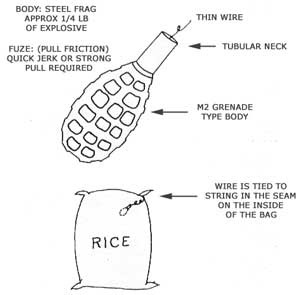
Rice Bag Booby Trap
The 11th Armored Cavalry Regiment reported that during OPERATION CEDAR FALLS any time a flock of small birds had been frightened away by approaching friendly troops, a large rice cache was discovered in the vicinity. Accordingly, any time a flock of birds was noticed, a search for a rice cache followed. It was also noted that intense booby trapping of a particular area was a good indication that valuable stores were hidden nearby.
The 173rd Airborne Brigade (Sep) reported, upon completion of OPERATION SIOUX CITY and THE BATTLE FOR DAK TO, that the use of scout dogs at company level aided in discovering enemy caches. However, it was noted that dogs became fatigued and were limited to approximately ten hours of work each day.
EXTRACTION and DESTRUCTION OF CACHES
The 5th Special Forces Group (Airborne), 1st Special Forces, reported that during a three month period when the bulk of the rice harvest had taken place within a province, units conducting combat operations had discovered large numbers of rice caches. Because of distances involved, and the location of these caches, it was difficult to extract or destroy this rice.
During OPERATION ATTLEBORO, the 1st Brigade, 1st Infantry Division found that rice located in crudely constructed bins could be effectively scattered by placing 43 pound cratering charges inside the bin and tamping them with loose or bagged rice. To preclude the use of scattered rice by the VC, CS in 8 pound bags was wrapped with one loop of detonating cord, spread over the scattered rice, and detonated. This unit further reported that a fast effective method for destroying bagged rice was to stack the bagged rice in a circular configuration, placing a 43 pound cratering charge in the center and tamping with bagged rice. Thirty to forty 200 kg. bags of rice were destroyed by one charge when using this method. All rice was so effectively scattered that contamination with CS was unnecessary.
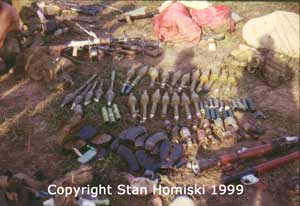
Large enemy cache uncovered by 3/4
Cavalry
The 1st Brigade, 101st Airborne Division reported that VC rice caches, particularly the larger ones of twenty to one hundred tons or more, were often located in inaccessible areas and were extremely difficult to extract. One possible solution was to arrange with the District Chief or Province Chief before an operation began to have two hundred to three hundred porters under the protection of military forces, available and ready. Evacuation by helicopters had sometimes been accomplished, but the suitability of employing this method to remove large quantities of rice was questionable.
Upon completion of OPERATION WHEELER, the 1st Brigade, 101st Airborne Division reported that of the total rice tonnage (198.7 tons) captured by tactical elements of the brigade, 49.6 tons had been located in areas that were inaccessible to helicopters or, due to the tactical situation, could not be extracted. This rice was destroyed by engineer and chemical personnel by seeding the caches with CS and then scattering it throughout the area using cratering charges. A total of eight hundred and ninety three pounds of bulk CS powder was utilized in these operations.
During OPERATION MALHEUR, an eighty ton rock salt cache was discovered by A Co, 2nd Bn (Airborne), 502nd Infantry. It was not tactically feasible to extract the salt and therefore, it was decided to destroy the salt in place. Twenty, eight pound bags of CS were dispersed throughout the cache and blown simultaneously with a cratering charge, spreading the salt and CS throughout the area. The next day an additional four hundred and eighty pounds of CS was dropped on the cache from the air. A low level flight was made over the area seven days later and the CS concentration was still heavy; there were no signs of activity in the area or that any of the salt had been removed.
During OPERATION CEDAR FAILS, the 11th Armored Cavalry Regiment (ACR) captured a considerable quantity of rice from widely dispersed caches in the IRON TRIANGLE. Since the 11th ACR could not extract or evacuate the rice, due to its combat mission, all possible means of evacuation were considered. Consideration was given to the use of surface transportation such as trucking companies. However, at the time there was insufficient transportation available to move the rice. Efforts were made to have the rice transported by the trucks organic to an ARVN Division. Although the request was not denied outright, the Division set a pickup date so far in the future as to be unacceptable. The 11th ACR then appealed to Province. After considerable pressure had been applied through advisory channels, the rice was partially extracted from the 11th ACR centralized collection point.
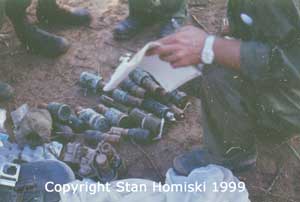
Enemy grenades being inventoried
During OPERATION MASTIFF, the 1st Infantry Division reported that an effective means of destroying rice by burning had been found. Gasoline, diesel oil and unused artillery powder increments were mixed with the rice to insure a hot fire. In this same operation, the 2nd Battalion, 2nd Infantry discovered a 50 ton rice cache which had been booby trapped. This rice was destroyed by pushing it into the Saigon River with a tank dozer. One other 75 ton rice cache was also destroyed by throwing it into the same river. During this same operation, a medical technical intelligence team was attached to the 3rd Brigade to examine and obtain samples of VC medical supplies taken from one of the base camps destroyed in the area. The team later reported that the antibiotics were of a type and brand that could be purchased on the open market in the Republic of Vietnam. The vitamin K (Ampoule K) found at the base camp was manufactured by laboratories TEVETE in Saigon. Large quantities of this item had been reported secretly captured by the VC in several places. The majority of the other drugs found were of the type normally found in VC captured medical supplies. The lot numbers and other information obtained from these medical supplies were of valuable assistance in determining and eliminating sources of supply to the VC.
SUMMARY OF SALIENT LESSONS LEARNED WITH RESPECT TO VC SUPPLY CACHES

Appendix 1 - Translation of VC document
Liberation Army
Doan 84
No. 44/cv "DETERMINED TO FIGHT AND DEFEAT US AGGRESSORS"
TO: Subordinates: K., K2., K3-, K7., C200. (Doan = Group; K = District; C = Company).
According to the agreement signed between Doan 84 and the local forward supply council; Doan 84 was to secure and store all supplies required for 1966 before August 1966. This agreement was sent to the various K (District). Now, we wish to remind you of building storehouses:
1. Based on the criteria of your branch, you should draft a specific plan for construction of various storage and issue sites.
2. You should use the requirements to calculate and estimate the materials and instruments needed for building the storages. The Group will study the estimate and approve the amount of money to be expended. At the same time, you must try by all means to purchase the necessary materials in advance in order to satisfy the immediate needs of holding the supplies.
3. During the rainy season, the provisions must be kept in high and dry places in order to prevent damage by termites and rain. Store keepers must kill termites, sweep the store, and repair leaks in the roof. The maintenance task must be looked after.
h. Following the construction of the storages, their defense must be rapidly set up to include: making fences, camouflaging, digging spike pits and laying minefields. Although temporary, the storages should be well camouflaged.
According to the criteria, each K (District) must have many caches which can accommodate assorted goods. The method of Construction should be carefully and scientifically studied. The caches must be appropriate to the goods. For example:
· Salt caches must be built underground. The floor should be lined with nylon sheets or straw. Only a small amount of salt should be stocked in the above ground storages.
· Salt fish should be kept in wooden airtight barrels set on stilts. They should be shaded with a roof.
· Rice depots: Cache frames must be set on stilts
· Clothing equipment storage: High, floored and with safe roof. This storage must be covered with curtains to shield light. Next to these curtains should be a layer of nylon or thatch used to prevent rain damage. Equipment must be set on the stilts. The blind must be tight so that mice cannot creep into the storage.
· Gasoline must be kept in cellars.
· Drug storages must be built as carefully as rice depots. Drugs should be set on a high and dry place.
Due to the great number of storages, the maintenance of storages must be concentrated. Ks (Districts):
· Know the number or storages, and the goods held in each store.
· Make a clear register in order to control issues and receipts.
· Unit leaders must control their storages and provide guidance for the cells.
Requisition and purchasing, transportation, and storage are three important tasks. Especially, in the storage task, the maintenance of goods is most important.
In the past, transportation was carried out well, but maintenance was still deficient.
You should try to step up this task because in the near future, provisions will be continuously sent to your unit in large quantity.
12 May 1966
Commander of Doan 84
NGUYEN VAN HUE
Method of preventing damage by termites:
In the maintenance task, some places applied an anti-termite method by using an aluminum plate. This method obtained favorable results. Now, we disseminate it to you for study and use:
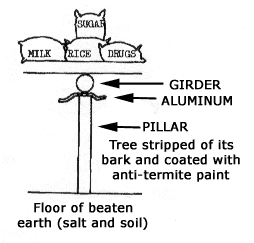
Thus, when climbing up to the plate, the termites can not reach the girder, and must climb down.

INTRODUCTION
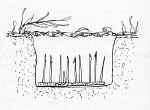 What
the Viet Cong (VC) and the North Vietnamese Army (NVA) lacked in the way of
firepower they made up for in ingenuity. Concealed devices used to inflict
casualties, booby traps were an integral component of the war waged by Viet Cong
and People's Army of Vietnam (PAVN) forces in Vietnam. These devices were used
to delay and disrupt the mobility of U.S. forces, in fact, the threat was often
enough to slow any advance to a snail's pace, divert resources toward guard duty
and clearance operations, inflict casualties, and damage equipment. They were a
key component in prearranged killing zones. Booby-traps could be covered by
snipers to further annoy the enemy or they might be the signal to spring an
ambush.
What
the Viet Cong (VC) and the North Vietnamese Army (NVA) lacked in the way of
firepower they made up for in ingenuity. Concealed devices used to inflict
casualties, booby traps were an integral component of the war waged by Viet Cong
and People's Army of Vietnam (PAVN) forces in Vietnam. These devices were used
to delay and disrupt the mobility of U.S. forces, in fact, the threat was often
enough to slow any advance to a snail's pace, divert resources toward guard duty
and clearance operations, inflict casualties, and damage equipment. They were a
key component in prearranged killing zones. Booby-traps could be covered by
snipers to further annoy the enemy or they might be the signal to spring an
ambush.
The use of booby traps also had a long-lasting psychological impact on Marines and soldiers and helped to further alienate them from civilian populations that could not be distinguished from combatants. The fear of booby-traps and mines was so great that units in the field (the boondocks) and the jungle (the zoo) were under stress the whole time. This created severe mental fatigue on both the commanders at platoon level and the individual soldiers.
Many of the materials for the mines and booby traps were of U.S. origin. These included dud bombs, discarded and abandoned ammunition and munitions, and indigenous resources such as bamboo, mud, coconuts, and venomous snakes.
The imaginative use of booby-traps by the NVA and VC caused many casualties amongst their opponents. Between January 1965 and June 1970, 11% of the fatalities and 17% of the wounds among U.S. Army troops were caused by booby traps and mines. To give one historical example, Charlie Company of the First Battalion, 20th Infantry sustained over 40% casualties in 32 days. They scarcely saw the enemy and took the casualties mainly from booby-traps and snipers. The effect on morale was such that these losses in men and the fact that they included virtually all of the experienced NCO's was said to have been more than partly responsible for the My Lai massacre that occurred.
Booby traps can be divided into explosive and non-explosive antipersonnel devices and anti-vehicle (i.e., tank, vehicle, helicopter, and riverine craft) devices. Antipersonnel booby traps were concentrated in helicopter landing zones, narrow passages, paddy dikes, tree and fence lines, trail junctions, and other commonly traveled routes. Anti-vehicle booby traps were deployed primarily on road networks, bridges, potential laager positions, and riverine choke points.
NON-EXPLOSIVE BOOBY-TRAPS
Non-explosive antipersonnel devices included punji stakes, bear traps, crossbow traps, spiked mud balls, double-spike caltrops, and scorpion-filled boxes.
By far the most common types of booby trap was the single punji stake. Punji stakes were sharpened lengths of bamboo or metal with needle-like tips that had been fire-hardened. Often they were coated with excrement to cause infection. Dug into shallow camouflaged holes and rice paddies and mounted on bent saplings, this was a common booby trap. Another similar device was a spiked mud ball suspended by vines in the jungle canopy with a trip-wire release. It functioned as a pendulum, impaling its intended victim.
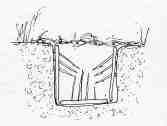 The
simplest pit type was a hole about 20 to 30cm deep. The floor of this trap was
then set with punji stakes which could easily pierce the canvas and leather
jungle boot. For added misery the spikes could be smeared with poison or human
excrement to induce blood poisoning or worse. There were many variations which
allowed the spikes to attack the sides of the leg. This was particularly favored
after the introduction of the reinforced soled jungle boot.
The
simplest pit type was a hole about 20 to 30cm deep. The floor of this trap was
then set with punji stakes which could easily pierce the canvas and leather
jungle boot. For added misery the spikes could be smeared with poison or human
excrement to induce blood poisoning or worse. There were many variations which
allowed the spikes to attack the sides of the leg. This was particularly favored
after the introduction of the reinforced soled jungle boot.
Punji traps were laid wherever the enemy soldiers were likely to land with force. The purpose of the pit was to increase the downward force of a walking man. Such places included the places that soldiers would throw themselves to escape gunfire - ditches, behind logs, in long grass etc; or where they would land with some force - stream banks, likely helicopter landing zones etc.
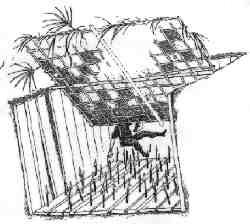 Side
closing traps were also to be found. These ranged from the same size as the
punji pit up to man-sized traps. These were more sophisticated versions of the
punji pit and were likewise smeared with excrement or poison.
Side
closing traps were also to be found. These ranged from the same size as the
punji pit up to man-sized traps. These were more sophisticated versions of the
punji pit and were likewise smeared with excrement or poison.
The second group of non-explosive traps used some form of mechanism to set them off - usually a trip wire. The wire could be stretched across a track as a delaying tactic or linked to a hidden man to be released on command as part of an ambush or to hit a selected target.
The swinging man trap was positioned on jungle trails and heavily
camouflaged. It comprised a weighted beam pivoted so that when the pressure
plate was pushed down the other, spiked end swung upwards with enough force to
impale the victim. The target area was the chest in order to inflict a messy
fatal wound.
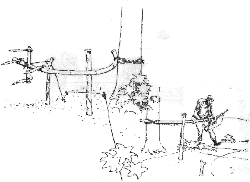
The bamboo whip was encountered on trails and was set off by a tripwire. It comprised a length of bamboo under tension and set with spikes (poisoned in the normal fashion) at chest height. The unfortunate victim would receive severe, it not fatal, wounds to the chest as it whipped across the trail
The spiked ball was another trap designed for jungle use. It was sprung by a trip wire which released the heavy clay ball set with sharp spikes. The force of gravity and the height of release combined to inflict horrific, usually fatal, wounds in the head and shoulders region.
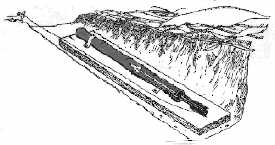 The
bow trap was a favorite in the heavily forested mountainous areas - though it
was not limited to these. It too was tripped by a wire which released a
tensioned bow set in a shallow pit. The target area was the leg. The arrow was
normally tipped with poison or human excrement.
The
bow trap was a favorite in the heavily forested mountainous areas - though it
was not limited to these. It too was tripped by a wire which released a
tensioned bow set in a shallow pit. The target area was the leg. The arrow was
normally tipped with poison or human excrement.
.
EXPLOSIVE BOOBY-TRAPS
Variations of explosive antipersonnel devices encompassed the powder-filled coconut, mud ball mine, grenade-in-tin-can mine, bounding fragmentation mine, cartridge trap, and bicycle booby trap. The mud ball mine was a clay-encrusted grenade with the safety pin removed. Stepping on the mud ball released the safety lever, resulting in the detonation of the mine. The cartridge trap was a rifle round buried straight up and resting on a nail or firing pin. Downward pressure applied to the cartridge fired it into the foot of the intended victim.
These were normally set to give warning of an approaching force or as part of an ambush. They were also employed to slow down a follow-up force after an ambush or to cover a withdrawal. The generally poor quality of the grenades used by the VC and NVA combined with their (relatively) long fuse of 5-6 seconds made them much less effective than they might otherwise have been. If circumstances permitted captured US fragmentation grenades gave a much better performance.
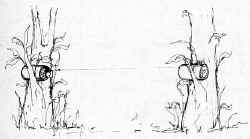 The
simplest trap was a trip wire connected to one or two grenades. The grenades
were placed in tubes of bamboo or tins to keep the safety lever from releasing
when the pin was pulled. The victim tripped the wire, set at whatever height,
pulling the grenades from their containers.
The
simplest trap was a trip wire connected to one or two grenades. The grenades
were placed in tubes of bamboo or tins to keep the safety lever from releasing
when the pin was pulled. The victim tripped the wire, set at whatever height,
pulling the grenades from their containers.
Command-detonated grenade '~daisy chains" were set along trails where patrols were likely. These grenades were set close together to inflict casualties at a point where there would be a bunched target. Bunched targets could occur naturally at certain terrain features or be created by using other traps to create casualties and then hitting the evacuation teams. The number of grenades chained together would be dependant on the strength of the puller and the length of the wire.
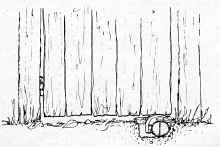 Grenades
were also set in the ground below gates so that the slightest movement of the
gate would detonate it right below the victims' feet. In areas where the
vegetation closed above the trail grenades were often set to shower splinters of
wood and metal downwards, causing messy wounds which would require urgent
casualty evacuation.
Grenades
were also set in the ground below gates so that the slightest movement of the
gate would detonate it right below the victims' feet. In areas where the
vegetation closed above the trail grenades were often set to shower splinters of
wood and metal downwards, causing messy wounds which would require urgent
casualty evacuation.
Claymores were an especially lethal form of mine with both the US and Chinese versions hurling fragments in a 60 degree fan. The locations that were usually mined were roads, edges of roads, enemy escape routes from ambush sites, crossing places, village approaches, behind fallen logs, behind walls, gaps of any type and so on.
Dud shells and bombs were salvaged and turned into traps, mines or sources of explosives. The shell most commonly available for this was the 105mm artillery shell.
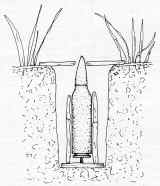 A
small variation of this used a 12.7 mm machine gun bullet set in a bamboo tube
with its primer resting on a nail or firing pin. The tip of the bullet just
protruded from the earth. A foot would press down sufficiently to set it off.
The bullet would explode shattering the victim's foot. If he was unfortunate
enough to be wearing the reinforced soled jungle boot then the steel or plastic
plate turned into shrapnel. The grunts called these 'toe poppers". They
were usually set in long grass.
A
small variation of this used a 12.7 mm machine gun bullet set in a bamboo tube
with its primer resting on a nail or firing pin. The tip of the bullet just
protruded from the earth. A foot would press down sufficiently to set it off.
The bullet would explode shattering the victim's foot. If he was unfortunate
enough to be wearing the reinforced soled jungle boot then the steel or plastic
plate turned into shrapnel. The grunts called these 'toe poppers". They
were usually set in long grass.
Traditional anti-personnel mines of all sorts from WW2 vintage onwards were used as they were intended and as part of booby-traps. One of the most common, and most hated, was the "Bouncing Betty". These mines were triggered by the release of pressure on the arming mechanism. Thus a soldier could stand on one, hear the arming mechanism operate and freeze. There he was standing erect knowing that if he moved his foot the mine would jump into the air and explode at chest height. Combat engineers came up with many extemporized methods of saving trapped soldiers.
The VC and NVA did not booby trap "souvenirs" to the same extent that the Japanese and Germans did in WW2. They did do it, but it was uncommon and possibly the more effective for that.
ANTI-VEHICLE TRAPS & MINES
Anti-vehicle devices included the B-40 antitank booby trap, concrete fragmentation mine, mortar shell mine, and oil-drum charge. The B-40 was a rocket-propelled antitank grenade, which in this instance was placed in a length of bamboo at the shoulder of a road and command-fired at a vehicle crossing its forward arc. The mortar mine was simply the warhead of a large-caliber mortar that had been separated from its body and retrofitted with an electric blasting cap. The oil-drum charge was based on a standard U.S. 5-gallon oil drum filled with explosives and triggered by a wristwatch firing device. This booby trap had immense sabotage applications for use against fuel dumps.
Soft vehicles could be destroyed by several of the anti-personnel mines or booby-traps described above. The VC and NVA used large numbers of mines to destroy enemy AFV's and were so proficient that the drivers and crews of the lighter sorts of AFV's rode on the outside of the vehicles. The crews of all vehicles would attempt to reduce the effectiveness of mine blast by putting layers of sandbags on the floor. This naturally affected the mobility of these vehicles. Some M-113's and M-551's were overloaded by doing this.
Captured artillery ammunition was prized for destroying tanks. The shell would be set in a culvert or similar location and command detonated under the track of the target. This was highly effective, particularly against the M-41's and M-551's. It was also very difficult to do correctly.
The habitual riding on the top of AFV's exposed the crews to sniper fire or to the anti-personnel traps set high enough to catch them. The threat must indeed have been real enough for the crews to accept the loss of their armour protection.
ANTI-HELICOPTER TRAPS
As the war progressed the prediction of likely helicopter landing zones became an art at which the VC and NVA became adept. The edges could be trapped or mined, the LZ's could also be mined or registered as mortar and heavy machine gun targets. However, a booby trap for helicopters consisted of wires connected to grenades atop posts at the edge of the LZ at a height to inflict blast and splinter damage on the debussing troops and splinter damage on the helicopters themselves, with the rotors being particularly vulnerable. Another particularly nasty anti-helicopter trap was the claymore mine sited on it's 'back' to fire up into the air as the helicopters were on final flare, sending hundreds of steel pellets through the soft belly of the helicopter. Still other mines were rigged into the tops of trees to be detonated by the rotor wash of nearby helicopters.
These devices were used on a scale never before encountered by U.S. military forces. As the war progressed and the casualty list stemming from booby traps mounted, U.S. forces employed numerous countermeasures. The most effective countermeasures were proactive in nature and focused on the destruction of underground VC/PAVN mine and booby trap factories and the elimination of raw materials used in the manufacture of such devices.
Tactical countermeasures included using electronic listening devices and ground surveillance radar; patrolling; deploying scout-sniper teams and Kit Carson Scouts; booby trapping trash left by a unit; and employing artillery ambush zones. Principal individual countermeasures were wearing body armor, sandbagging the floors of armored personnel carriers (APC's), and abstaining from the collection of "souvenirs".

Characteristics of NVA & VC Smallarms
During the early war years, the VC relied on a mix of weapons from various sources; captured French and Japanese weapons, US made .30 caliber M-1 (semi-automatic) and M-2 (semi- and full automatic) carbines and the .45 caliber Thompson M1928A1 as well as other SMG's such as the 9mm MAT-49 and the 7.62mm PPSh-41. Many of these weapons came by way of capture as well as international arms sales. However, as supplies from the North began to filter down into RVN, new weapons from the Russians and Chinese began to make their appearance.
Synonymous with the NVA regulars and Vietcong Mainforce units, the basic infantry weapon was the Soviet 7.62mm AK-47 assault rifle, or the Chicom copy Type 56. Whilst the Chicom Type 56 was the predominant rifle, the weapon was referred to generically as the AK-47 irrespective of the country of origin. Capable of firing semi- or full automatic at the flip of a switch the AK-47 was issued in several different configurations.
Almost as equally widespread as the AK-47 was the Soviet 7.62mm SKS carbine or Simonov, a semi-automatic rifle which was especially common amongst the regional and local VC forces.
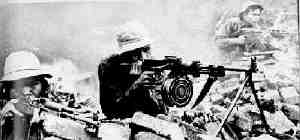
Left to Right: SKS carbine, RPD LMG,
AK-47
By the time of the Tet offensive in 1968, the NVA and Main Force VC were almost universally armed with modern Soviet or Chicom weapons although the regional and local VC forces still carried weaponry of mixed vintage. Main Force VC units around 1965 - 1966 were generally armed in the same manner as their NVA counterparts and there is much evidence which exists to suggest that Main Force VC consisted of substantial numbers of early war NVA regulars.
Apart from the increasing availability of the AK-47 and the SKS as the war progressed, another more important consideration prompted their adoption as the standard infantry weapons - that of ammunition. Both weapons use the Soviet 7.62mm M43 or Chicom Type 56 cartridges. Other weapons, whilst reasonably prolific, nonetheless presented logistical problems in that not only did they comprise a mix of calibers but even weapons of the same or similar caliber required separate ammunition types.
Standardisation around the 7.62mm M43 also suited the NVA/VC in their choice of squad support weapons since the excellent Soviet 7.62mm RPD light machine gun (Degtyarev) and it's Chicom counterpart, the light machine gun Type 56, used the same M43 ammo load as the AK-47 and SKS carbine.
Larger caliber machine guns, such as the 7.92mm Chicom Type-24 heavy machine gun, were, for the most part, employed in defensive positions and used as anti-aircraft weapons as well as in a ground support role. Many of these weapons were mounted on metal or rubber wheels in order to aid their crews in deployment while others were carried by one man or a crew of two or more. These weapons were considered as particularly high priority for Allied Gun Ships attempting ground suppression and as a consequence were often employed in operations quite near to the border so that they could be extracted from an AO reasonably rapidly.
A mark of rank amongst the NVA and VC (indeed as in most armies) pistols and revolvers were carried by officers, political staff and occasionally by senior NCO's. The two most common weapons were the 7.62mm Soviet TT-33 Tokarev and the 9.5mm Makarov automatic pistols.
Although VC and NVA units carried infantry anti-tank weapons they were used more in the role of anti-personnel than anti-armour. The most common were the Soviet RPG-2 and the Chicom copy Type-56. A more modern weapon, the Soviet RPG-7 (Chicom copy Type-69) was also widely used and particularly effective against the aluminium hulled US M-113.
All of these weapons were 40mm and capable of penetrating up to 6" of armour at ranges of 100 - 500 meters. Ammunition however differed, with the RPG-2 round being fin-stabilised while the RPG-7 round was finless. One interesting feature of RPG-2 is that they could only be shoulder fired right-handed since the vent for the blast was located on the right hand side of the weapon itself close to the firing mechanism housing which would be lethal to a left-handed user.
Both the VC and the NVA were renowned for their skill with mortars. These varied from 60mm to 160mm but by far the most common were the Soviet 82mm M-1937 and the Chicom copy Type-53. Both of these had a range of just over 3kms. Comprising a sight, tube, bipod and base plate (total weight of 123lbs) the weapon required a crew of three, usually with a fourth crew member acting as an additional ammo carrier.
Another popular mortar was the French made Stokes-Brandt 60mm M-1935 and various copies of this weapon including the US 60mm mortar M-2 and the Chinese 60mm Type-31. All three of these fired any type of 60mm ammunition and with a total weight of around 40lbs could be ported by a single man, however a crew of two was normal.
Irrespective of the weapon carried and it's source, NVA units infiltrating into RVN were, by 1965, adequately armed for confrontation with Allied infantry. By 1967 the VC were also carrying a substantial number of modern arms. Where both the NVA and the VC lacked firepower was in their absence of supporting fire from artillery, air and armour and these particular systems the US had in abundance.
AK-47 7.62mm ASSAULT RIFLE
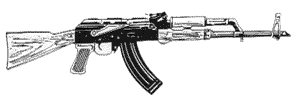
Easily recognised with its high front sights, large selector/safety switch on the right side and the long, curved banana magazine, this is the Soviet version with a conventional wooden buttstock. The AK-47 is a gas-operated, magazine-fed rifle which has a semiautomatic ROF of 40 rounds (effective range about 400 meters), increasing to 100 rounds on fully automatic (effective range about 300 meters). It has a 30 round detachable box magazine. Renowned for it's durability, the AK-47 is shorter and heavier than the M-16 but with a lower ROF and muzzle velocity.
SIMONOV 7.62mm SELF-LOADING RIFLE (SKS)
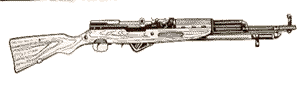
A 7.62mm semi-automatic carbine with an effective range of 400 meters, the SKS has a 10 round integral magazine and an ROF of 30-35 rounds per minute. The SKS resembles a conventional bolt action rifle but is equipped with an integral folding bayonet under the muzzle. Used extensively by the VC, it weighed 3.86kg, had a length of 1020mm and a muzzle velocity of 735m per second.
RPD-7.62mm GPMG
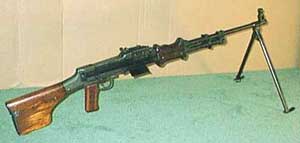
The standard infantry squad support weapon, the RPD was analogous to the US M-60 and fired a 7.62mm slug from a 100 round belt which was usually contained in a drum mounted below the gun. The drum itself could be changed in a matter of seconds by an experienced gunner and protected the ammo from dirt and hence jamming. With a maximum rate of cyclic fire of about 150 rounds per minute, an effective range of 800m and rapid reload time, this light and uncomplicated weapon was capable of laying down sustained heavy fire. The gunner was usually accompanied by an assistant acting as an ammo carrier, loader and capable of taking over as the primary gunner in the event of the main gunner becoming a casualty. The RPD was approximately 1036mm in length (521mm barrel ) and had a muzzle velocity of 700m per second.
PPSh-41 7.62mm SMG

The weapon had a fire-rate selector lever positioned just in front of the trigger, allowing the rate of fire to be changed rapidly without the weapon moving off the point of aim. The two-piece bolt handle allows the bolt to be locked in either the forward or the rear position. The original weapon had two different magazines; a 71-round drum or a 35-round box. The drum magazine seems to have fallen out of favour, and most of this type of weapon seen in Vietnam used the box. This may have been a result of the Chinese connection. The PRC Type 50 SMG differed only slightly from the PPSh41, mainly in that it only fitted the 35-round box magazine. The most interesting variant of the weapon was the K50M, which was a Vietnamese modification of the Type 50. The Vietnamese removed the wooden butt stock and replaced it with a wooden pistol grip and a French-style sliding wire butt stock similar to that on the MAT49. At the front end of the weapon, they shortened the perforated barrel jacket, left off the muzzle brake, and attached the foresight to the barrel, giving the gun a shape strongly reminiscent of the MAT49. The K50M ended up being about 500 g (1.1 lb) lighter than the PPSh41 at 3.4 kg (7.5 lb) as opposed to 3.9 kg (8.6 lb). The weapons were all blowback operated and had an effective range of about 150 m (164 yd).
MAT49 modified 7.62mm SMG
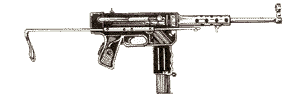
Produced by the Manufacture d’Armes de Tulle (MAT) in 1946 and using the 9mm Parabellum cartridge this SMG was adopted by the French Army in 1949 (hence the designation MAT49). The weapon was widely used by French forces in Indo-China and many found their way into the hands of the Vietminh and eventually the Viet Cong.
The Vietnamese modified the weapon to fire the Soviet 7.62mm x 25P ammunition and it’s PRC equivalent by fitting a longer 7.62mm barrel. However, they did keep all the essential features of the MAT49 except for replacing the 32-round box with a 35-round magazine.
One of the remarkable features of the weapon was the sliding wire butt stock which could be pushed forward out of the way for carrying and pulled to the rear if it was to be used in firing. The magazine housing on the receiver could be rotated forward through 90-degrees (even with the magazine fitted) to lie along the barrel. These features made the MAT49 particularly suitable for troops who required compactness in carriage.
At the back part of the pistol grip was a grip safety, which was operated by the action of squeezing the pistol grip when firing a round. This released the safety catch. When the grip safety was not squeezed, it locked the bolt in the forward position, and locked the trigger when the weapon was cocked. The lock was released by the pressure of the palm of the hand. The weapon could not be accidentally discharged.
The Vietnamese modification increased the cyclic rate of fire from 600-rounds per minute to 900-rpm.
Chicom Type-56, 7.62mm ASSAULT RIFLE
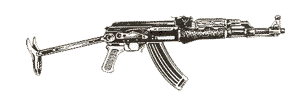
The Chinese copy of the original Soviet AK-47, the Type-56 has a folding metal stock.
Type-24, 7.92mm HEAVY MACHINEGUN
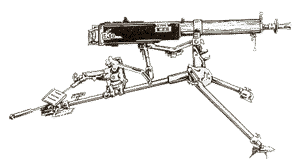
A Chinese copy of the German WWI vintage Maxim machine gun often used in an air defence role.
RPG-7 ROCKET LAUNCHER
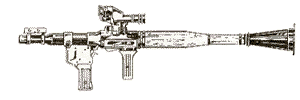
The RPG-7 (CHICOM Type-69) is a muzzle loaded, shoulder fired antitank grenade launcher. The VC and NVA used the RPG7V, a Soviet produced short-range, anti-armour, rocket-propelled grenade, from 1967 against armoured vehicles, defensive positions, personnel and even helicopters. This smoothbore, recoilless weapon consists of a launcher tube fitted with a simple iron sight or a more sophisticated telescopic range-finding sight, and a HEAT rocket grenade projectile with a caliber of 40mm. The RPG-7 has an effective range of 300 meters against moving targets and up to 500 meters against stationary targets. The projectile explodes either on impact or at its maximum range of 920 meters.
TOKAREV TT33 7.62mm AUTOMATIC PISTOL

First introduced in the 1930’s and utilising the self-cocking design from Colt, the Tokarev TT33 was used extensively by Soviet forces in WWII and was produced in nearly all Warsaw Pact countries and the PRC.
The Chinese Type-54 could be distinguished from the Soviet TT33 by the serrations on the slide and by the Chinese ideograms on the pistol grip (the Soviet weapon had a star in the center of the pistol grip). The Soviet TT33 had alternate narrow and wide vertical cuts, whereas the Type-51 and Type-54 had uniform narrow markings, to aid gripping the slide when manually cocking the weapon.
There was no safety mechanism but the hammer could be locked at half-cock and the weapon was normally carried around with a round in the chamber.
Production of the weapon in the USSR stopped in 1954, but continued in other Communist countries, notably the PRC. The pistol was widely used by VC and NVA officers.
The Tokarev TT33 fired the Soviet 7.62-mm x 25 Type-P pistol cartridge. It operated on a recoil single action and was semi-automatic, feeding ammunition from an 8-round box magazine. Maximum ROF was 32-rpm and with a maximum effective range out to about 50-meters.
The pistol was quite heavy, weighing about 1-kg (2.2-lbs) when loaded and was 196-mm (7.72-inches) in length.
MAKAROV PM 9mm AUTOMATIC PISTOL

The Pistolet Makarov (PM) replaced the Tokarev in the early 1950’s in the Warsaw Pact countries and was produced in the PRC as the Type-59. originally copied from the West German Walther PP (police pistol) of the 1930’s the Makarov was chambered for the 9-mm round rather than the 7.65-mm cartridge of the original pistol and used Soviet 9-mm x 18 ammunition rather than the original NATO 9-mm x 19.
Following it's introduction the Makarov became the standard pistol in most Euro-Asian Communist forces.
The pistol was operated by a blowback, self-loading double action, and loaded from an 8-round box magazine. It measured 160-mm (6.3-inches) in length and weighed 800-grammes (1.8-lbs) when loaded.
The pistol grip was slightly bulky, making firing it a little uncomfortable. Soviet manufactured weapons had a star in the center of the pistol grip. There was a simple safety catch at the rear of the slide, and a slide stop on the outside of the receiver, both of which could be operated by the firer’s thumb if right handed.
NORTH VIETNAMESE ARMORED FORCES

The People's Army of Vietnam (PAVN) was founded in August 1945, with most of its equipment being obtained from the locally defeated Japanese forces. However, no armored vehicles were put into use by the PAVN, which was soon forced to fight a guerrilla war against the French. In 1952, a small number of PAVN officers were sent to study armored warfare operations at Wu Ming in China. However, these troops were not used to set up armored units. Instead, they were sent back to Vietnam to serve as specialists to develop antitank tactics and to create special anti-armor units. At Dien Bien Phu the PAVN captured at least two M-24 tanks that were still functioning and used them for propaganda purposes.
The PAVN was reorganized and expanded during the period between 1955 and 1960, and new anti-armor artillery and armored units were created. Fearing an invasion from South Vietnam, the PAVN at first reinforced its anti-armor assets and created several battalions equipped with Soviet 57mm guns and German PAK 40 75mm guns. In 1956, an armored company was also set up, equipped with M-8 armored cars and M-3 half-tracks. The origin of these vehicles is unknown; they could have been captured from the French or delivered by China. These armored vehicles participated in a military parade at Hanoi in 1956 and were later assigned to security platoons deployed around VPAF air bases.
The PAVN set up its first tank unit, the 202nd Armored Regiment, on 5 October 1959. The numerical designation of the regiment was derived from the 202 cadre members who had been trained in China and the Soviet Union. The unit was initially equipped with some 35 T-34-85s and 16 SU-76s. In 1964, the 202nd Armored Regiment was expanded to include three battalions, which were equipped respectively with T-54, T-34-85, and PT-76 tanks and SU-76 self-propelled guns. An Armored Forces Directorate was created in the summer of 1965 to coordinate the use of the armored units and to define and employ doctrine.
|
|
|
T34-85 |
Having only about one hundred tanks in service, the PAVN did not advocate their use in mass. Its doctrine stated that armor would be employed during an attack, when feasible, to reduce infantry casualties. However, only the minimum number of tanks required to accomplish the mission would be used. Battle drill dictated that lead tanks were to advance firing and be supported by fire from other tanks and from artillery. Close coordination between tanks and supporting infantry was stressed as a key to success in the attack. Because the North Vietnamese lacked air power, they placed strong emphasis on camouflage training in armor units. Facts later proved that armored battalions were able to move great distances without being detected.
As early as 1962 cadres from the 202nd Armored Regiment had joined the staff of the Central Office for South Vietnam (COSVN) as armor advisors. They asked for a reinforcement of infantry anti-tank weapons, and in 1966 the number of RPG-2s (B-40s) was increased in each PAVN infantry company from three to nine. Each infantry regiment also received an allocation of eighteen RPG-7s (B-41s). The Viet Cong troops also replaced their bazookas and 57mm SR guns with RPG2s and 75mm SR guns. Most of the losses inflicted on US and ARVN armor during the conflict was due to these infantry rocket launchers and mines.
It was only in 1967 that the 202nd Armored Regiment sent two independent companies of PT-76 amphibious tanks to be posted near the Laotian border. They were intended to support an attack against one of the US and ARVN special forces observation outposts that overlooked the Ho Chi Minh Trail. In December 1967, one of the PT-76 companies was sent to the Plain of Jarres in Laos, while the remaining company was put under the control of the 198th Armored Battalion with a BTR-50PK armored personnel carrier (APC) company. The unit was then attached to the Khe Sanh- Road 9 Front.
|
|
|
PT-76PB |
On 26 January 1968, the PT-76s from the 3rd Company of the 198th Armored Battalion attacked the Ta May outpost in support of the 24th Infantry Regiment. The little ARVN garrison was quickly overwhelmed in this first combat against the PAVN armored forces. Encouraged by this success, the PAVN redirected the battalion against the Lang Vei Special Forces Camp near the besieged garrison of Khe Sanh.
On the night of 6 February 1968, 16 PT-76s attacked the Lang Vei position, which was held by over 500 troops. It was the first time that US soldiers faced Communist armor in Vietnam. Despite stubborn resistance, the PAVN advanced methodically, destroying bunkers at point-blank range. Throughout the night and far into the next day the resolute defenders held on, as their own artillery fire and air strikes deliberately pounded the position. The few survivors eventually broke out and fled to Khe Sanh. The North Vietnamese lost six PT-76s at Lang Vei. The PAVN Armor Command reported that the action was a great success. Despite enemy air strikes, the attack adhered strictly to the doctrine regarding the use of armor and contributed in reducing infantry casualties with a one-for-six ratio in favor of the PAVN.
US forces encountered North Vietnamese tanks a few other times in South Vietnam. A PT-76 was knocked out by a 90mm SR gun during an attack on a Special Forces camp at Bu Dop in 1968. Another was located by a helicopter on 10 February 1968 and destroyed by a tactical air strike during Operation "Pegasus", the relief of Khe Sanh Combat Base.
After the Khe Sanh battle, the 198th Armored Battalion was re-deployed near the DMZ, along the Ben Hai River. It was there that one of the PT-76s was surprised while crossing the river. It was destroyed at extreme range by an M-48 of the 3rd US Marine Tank Battalion. On the night of 3 March 1969, the 4th Armored Battalion from the 202nd Armored Regiment attacked the Special Forces camp at Ben Het. The attack was carried out by a dozen PT-76 tanks and an equal number of BTR-50PK APCs in order to destroy the camp's battery of M-107 SP guns. One of the leading PT-76s struck a mine and was immobilized, but it continued to fire with its 76mm gun. The other armored vehicles were then engaged by a platoon of M-48s from the 1st Battalion, 69th Armor and two M-42s. The unexpected presence of Patton tanks went unnoticed by the North Vietnamese, who decided to retreat after losing two PT-76s and one BTR-50PK. These were the only occasions that American tanks clashed with PAVN armor. At that time, US intelligence sources estimated that the PAVN fielded about 60 T-54s, 50 T-34-85s and 300 PT-76s. A small number of SU-76s was also retained for training purposes. The APCs in use included the wheeled BTR-40 and BTR-152 and the tracked BTR-50.
The PAVN then decided to engage its armor in Laos. In June 1968, a force of ten PT-76s supported an infantry assault that led to the fall of Muong Suoi. In March 1969, the 195th Independent Tank Company was attached to Front 959, which controlled operations in the Plain of Jarres. The company operated 25 PT-76s and had an attached platoon of BTR-40 armored cars. In August 1969, the Laotian Government forces launched Operation "Kou Kiet" and recaptured most of the Plain of Jarres. The offensive was preceded by an intense interdiction campaign by the USAF, which cut the unit off from its supply sources. Suffering from a lack of fuel, the crews were ordered to abandon their tanks and to sabotage them before departing. This was the worse defeat suffered by the PAVN Armor Command up to this point.
In October 1969, the 195th Independent Tank Company was re-equipped and led a counter-offensive, which retook all lost ground. On 17 February 1970, the PAVN continued its advance and attacked Lima Site 22, a Hmong outpost, but the four PT-76s engaged in the assault were lost to mines. A week later, another armored thrust smashed through the outpost.
In 1971, in the Boloven Plateaux in southern Laos, the PAVN deployed the 3rd Independent Tank Company, which was also equipped with PT-76s. The unit supported the operations around the city of Attopeu. The armored units in Laos were recalled into the area of Tchepone to counter Operation "Lam Son 719", the ARVN offensive to severe the Ho Chi Minh Trail. The 202nd Armored Regiment also reinforced the PAVN 70B Army Corps with two additional tank battalions equipped with T-54 tanks. On 19 February 1971, the North Vietnamese armored assault against the LZ 31 was repulsed with heavy losses. The ARVN M-41s proved to be superior in tank-versus-tank fighting. A week later, after several assaults, three T-54s finally gained the summit of the position, forcing the defenders to withdraw.
The PAVN tanks now attacked the remaining ARVN positions around Aloui and engaged in several other battles with the South Vietnamese 1st Armored Brigade. PAVN T-54s and PT-76s took two South Vietnamese Marine positions despite the fact they were atop hills of 550 meters (610 yards) and 543 meters (593 yards) in height, respectively. In fact, during this campaign the North Vietnamese armor succeeded in operating in rugged and mountainous terrain, while the ARVN tanks, which were forced to retreat along the narrow Route 9, were routed. At the completion of the operation, the ARVN claimed 30 PAVN tanks destroyed and the loss of only 6 M-113s. Air strikes claimed another 60 tanks.
In 1971, the PAVN reorganized and expanded its armored forces. A new regiment was set up in November - the 201st Armored Regiment. It was followed by the 203rd Armored Regiment with the 171st, 198th and 297th Armored Battalions. The old 202nd Armored Regiment was also reorganized along with the 4th, 177th and 397th Armored Battalions.
Each armored regiment was organized with three battalions, usually two tank battalions and an APC battalion. The armored regiment rarely used standardized equipment. It was not unusual to have in the same regiment one battalion equipped with T-54 tanks, another with PT-76s and a third with BTR-50 APCS. Each tank battalion had a strength of 38 vehicles; each APC battalion consisted of between 30 to 35 vehicles.
Until 1975 the armored battalion usually operated independently. Each tank battalion had three companies, usually equipped with the same equipment. However, there were exceptions. For example, the 195th Tank Battalion had two companies equipped with Type 59 tanks and one company with T-34-85s. Another example was the 2nd Armored Battalion, which had one company of Type 59 tanks and two companies of K-63 APCS. In fact, the PAVN armored formations exhibited great flexibility in terms of organization and equipment. The strength of a specific unit was then tailored to a specific task or tactical situation, and even to the availability of vehicles. This situation, nevertheless, caused more logistical problems.
|
|
|
K-63 |
The Soviets and Chinese delivered additional equipment to the PAVN in 1970 and 1971, including new T-54B, PT-76, Type 59 and Type 63 tanks. China furnished most of the APCs in service in the form of rugged and reliable K-63. By January 1972, the PAVN began to deploy its armored units in preparation of the Nguyen Hue Offensive. The 171st Tank Battalion from the 203rd Armored Regiment was sent down the Ho Chi Minh Trail to a location east of Tay Ninh, near the Cambodian border. The 38 heavily camouflaged T-54Bs of the unit drove themselves over 900 kilometers (560 miles) in two months. It was thus far the longest deployment of PAVN armor. En route, the battalion witnessed thirty air strikes, but none of its tanks were hit.
The main thrust of the PAVN armor occurred across the DMZ on 30 March 1972, when the 201st and 202nd Armored Regiments supported the attack of five infantry divisions against the ARVN Military Region 1 in what was to become known as the Nguyen Hue Campaign or, Easter Offensive. The two regiments were equipped with Type 59, Type 63 and T-54 tanks and K-63 APCS. The two units were temporarily halted by the ARVN I Armored Brigade at Dong Ha, but they finally pressed on and reached the South Vietnamese defensive lines north of Hue. In September, an ARVN counterattack pushed the PAVN back to Dong Ha. Thanks to effective air strikes and the ARVN tankers, who were better trained in long-range shooting, the two PAVN regiments suffered heavy losses.
|
|
|
Type
63 |
In the Central Highlands, the ARVN forces deployed around Dak To and Tan Canh were routed by the 203rd Armored Regiment, which was equipped with T-54, T-34-85 and PT-76 tanks. Another assault against Ben Het on 9 May failed when three PT-76s were destroyed by TOW missiles launched from a US Army trial gunship helicopter unit. On 13 May, without artillery preparation, two PAVN regimental task forces, supported by tanks, attacked Kontum from Route 14. Two other armored assaults took place in the northeastern and southern part of the town. The ARVN infantry fought tenaciously, destroying a dozen tanks with M-72 LAW rocket launchers. Two other armored assaults, which took place on 26 and 27 May, succeeded in taking the northern part of town. Continuously attacked by TOW-armed helicopters and fighter bombers, the PAVN were pushed back on 31 May. By mid-June, when the siege of Kontum was relieved, the PAVN had lost around 80 tanks and suffered 4,000 casualties.
The offensive against An Loc, near Saigon, was supported by the already deployed 171st Tank Battalion and the 20th and 21st Independent Tank Battalions, which were equipped with T-54s. The town was encircled and Route 13, which led to Saigon, was severed by the 20th Independent Tank Battalion, which had crossed the Saigon River undetected on a pontoon bridge. On 13 April, the 20th and 21st Independent Tank Battalions attacked An Loc in support of the 9th Infantry Division, but the coordination between artillery, tanks and infantry was poor. The ARVN soldiers held their ground with LAW anti-tank rockets. An entire column of six T-54Bs that had reached the main avenue of the town was completely wiped out. Another attack force, which was caught in a pre-planned B-52 strike area, lost an entire platoon of tanks.
|
|
|
T-54B |
On 15 April, the 171st Tank Battalion joined the second offensive against An Loc. After losing a further dozen T-54s, the PAVN pulled back and besieged the city. An independent armored company was then set up with captured ARVN M-41 tanks and M-113 APCS. The remaining battered armored formations were regrouped within the 26th Armored Regiment, with two depleted tank battalions and one APC company. This provisional armored regiment was disbanded in 1973.
On 9 May 1972, the PAVN tried one more time to take An Loc, launching an assault that was supported by 40 tanks. B52 strikes, fighter bombers and Cobra helicopters hit the attackers. On 12 May, the T-54s reached the northern and eastern parts of the city and commenced direct tank fire from entrenched positions. On 12 June, the last PAVN units were driven from An Loc after losing nearly all the 40 tanks committed.
The year 1972 ended with new fighting in Laos. The 195th Independent Tank Company, which was brought up to battalion status, received additional Type 59, T-34-85s and K-63s. The unit supported the attack against Sam Thong and the Hmong Headquarters at Long Tien base. The 3rd Independent Tank Company in the Boloven Plateaux was expanded, becoming the 6th Independent Tank Battalion. The unit, which was equipped with PT-76s and T-34-85s, operated around Pakse until the ceasefire in 1973.
Most of the PAVN armor losses of 1972 were attributed to air strikes. The North Vietnamese had tried to protect their units by deploying a considerable number of 37mm and 57mm AA guns and SA-7 (A-12) missiles. Since 1969, some AA artillery units were also equipped with BTR-40As armed with twin 14.5mm machine guns. These armored vehicles operated within independent mobile AA artillery companies. In 1972 they were also used in scouting missions for the benefit of tank units. They were supported by a few ZSU-57-2 air defence vehicles and some locally modified T-34 tanks armed with twin 37mm AA guns mounted on an open turret. The PAVN also modified some BTR-50PK APCs by installing a platform on the rear deck mounting a 14.5mm machine gun. In December 1972, the 237th AA Artillery Regiment was re-equipped with the sophisticated ZSU-23-4 Shilka. During the 1975 campaign, only a battery of four Shilkas was effectively engaged in combat. The remaining vehicles of the regiment arrived too late, after the fall of Saigon.
|
|
|
|
ZSU-57-2 |
ZSU-23-4 |
During the 1972 offensive, the PAVN lost around 400 tanks and APCS. The North Vietnamese then decided to reconstitute and expand their armored forces. The most obvious shortages were assessed, and the infantry divisions were trained to operate more closely in coordination with the artillery, air defense units, and armored forces. The PAVN identified two specific Blitzkrieg-style tactics for the use of armored forces: the "sudden assault" and the "deep advance". The notion of sudden assault implied crushing enemy resistance by a quick attack using the shock effect of tanks to throw the enemy off balance. A successful sudden assault would open the way for an effective deep advance, or pursuit.
In 1973, the Soviets delivered additional T-55, T-54, T-34-85 and PT-76 tanks and a small number of BTR-60PB APCS. US sources indicated that a small number of ISU-122 self-propelled assault guns was also delivered. If that proved correct, it was the heaviest armored vehicle that entered service with the PAVN. Little is known about the operational record and combat use of the SU-100 tank destroyer that was also received at the same time in order to supplement the surviving SU-76s. China also delivered more Type 59 and Type 63 tanks and, more importantly, additional K-63 APCS. In fact, the K-63 became the main PAVN APC used in the 1975 offensive.
|
|
|
BTR-60PB |
In 1974, the PAVN could deploy nine armored regiments: the 201st, 203rd, 204th, 206th, 207th, 215th, 273rd, 408th and 574th Armored Regiments. These units regrouped some 29 armored battalions. US intelligence estimated that the North Vietnamese were then using some 600 tanks and 400 APCS.
Learning the costly lessons of the Nguyen Hue Offensive, the PAVN believed that future combat would be fought at the combined army corps formation level. Each of these corps would have between three and four infantry divisions, one AA artillery division, one artillery brigade and one armored brigade. The 202nd Armored Regiment was the first unit to be brought to brigade strength, with five armored battalions, and was attached to the 1st Army Corps in October 1973. The 2nd Army Corps was set up on 15 May 1974, with the attached 203rd Armored Brigade. The remaining armored units were put directly under the command of the PAVN Armored Forces Directorate. In December 1974, two other unidentified armored brigades were created and placed under the control of the Strategic General Reserve.
The 1975 offensive began with an assault against Ban Me Thout in the Central Highlands. Leading the attack was the 273rd Armored Regiment with a battalion of T-54s, a battalion of T-34-85s and another of K-63s. The quick collapse of ARVN Military Region 2 took Hanoi by surprise. The South Vietnamese decision to abandon Hue further to the north created a panic that was fully exploited. The units of the Tri Thien Front and the two divisions deployed near the Laotian border went on the offensive, quickly followed by the 2nd Army Corps. The attached 203rd Armored Brigade received orders to move toward Hue, but the unit learned that the ancient capital was already taken when its vehicles were still crossing the DMZ. In fact, the brigade played only a minor role in the fall of ARVN Military Region 1. On 23 March 1975, the 574th Armored Regiment, attached to the Tri Thien Front, drove into Da Nang and crushed the last ARVN resistance in the area.
After the fall of Da Nang, it was decided to take Saigon before the first rains of the wet season. The 2nd Army Corps moved south, along the coastal highway, with the T-54s and Type 63s from the 574th Armored Regiment in the lead. In the Central Highlands, the units which had taken Ban Me Thout and Pleiku were now grouped within the newly created 3rd Army Corps. They rolled down to the coastal plains and joined forces with the 2nd Army Corps. The PAVN units also pressed into service captured or abandoned ARVN armored vehicles. The tanks were used only on a small scale, notably the M-41s, while the M-113 APCs were used extensively to reinforce the small amount of K-63s, BTR-50PKs, BTR-152s and BTR-60PBs.
By advancing in tight, combined arms groups, with infantry in APCS, trucks and captured vehicles, the tank units maintained constant pressure on the withdrawing enemy. When resistance was encountered, the leading units deployed for a sudden assault while following units bypassed the enemy location to continue the pursuit. By these means, the PAVN armored units were able to cover an average of 50 kilometers (31 miles) a day. Within two months of the beginning of the Ho Chi Minh Campaign, North Vietnamese tanks were in striking distance of Saigon.
By mid-April 1975, the 1st Army Corps, with the attached 202nd Armored Brigade, was also deployed around Saigon. It was followed by the newly created 4th Army Corps, which had three armored battalions attached. Finally, from west and southwest of Saigon was created the 232nd Tactical Force, which grouped three infantry divisions, three battalions and one company of armored vehicles.
During the final assault against Saigon, most of the PAVN armored units were still on the roads, speeding toward the South Vietnamese capital and crushing on the way the last pockets of ARVN resistance. Some regiments saw their organic battalions dispersed on different fronts. For example, the 206th Armored Regiment had relinquished its 1B Battalion, which was equipped with a company of Type 59 tanks and two companies of K-63s, to the 202nd Armored Brigade. The remaining 195th and 575th Armored Battalions, equipped with a mix of T-54, Type 59, T-34-85, Type 63 and K-63, were engaged independently to support clearing operations around Xuan Loc and Bien Hoa. The day that Saigon was taken, the PAVN engaged 400 tanks and APCs against the last defensive positions of the city. On 30 April, T-54 number '843' from the 203rd Armored Brigade crashed through the gates of the South Vietnamese presidential palace. South Vietnam had fallen.

Characteristics of NVA and VC Mortars
Easily portable and simple to operate, the mortar was ideally suited to the terrain of South Vietnam and the tactics of the NVA and, in particular, the Viet Cong. Ever conscious of US firepower, a well trained mortar team could set up a mortar position out of the sight of the enemy, loose off a number of rounds at maximum range and, due to the mortar rounds long flight time, be moving away from the firing site before the first rounds impacted on the target. Such maneuverability severely restricted allied counter-mortar fire or retaliation by air.
The mortar was particularly suited for attacking standoff targets such as US firebases or installations where its greater accuracy over the rocket allowed it to be used against point targets.
The VC and NVA deployed a wide variety of mortars, ranging in size from the small 50mm to the breech-loaded 160mm. However, the most common types were: the light Chicom Type 63 60mm mortar, Soviet M1937 and M1943 82mm mortars and the Soviet M1938 and M1943 120mm mortars.
NVA mortar positions were often cynically sited near to inhabited areas in order that the crew could seek refuge from air attack after firing a few rounds. The mortar position itself was generally a hole approximately 1.7-meters deep and 2-meters in diameter, invariably excellently camouflaged, with only the mortar tube fire path uncovered during firing. These mortars were frequently sited to fire along the long axis of the target in order to take advantage of the their small deflection error.
The lightweight 60mm mortar, weighing only 45-lbs when assembled for firing, was an ideal standoff weapon. The crew could fire it, then pick it up and move with it. With a maximum range of nearly two kilometers and a minimum range of only 90-meters, it also made for an excellent infantry support weapon.
LIGHT MORTARS: 60mm mortar (CHICOM Type 31 and Type 63, Soviet M40 series)
The Type 31 was a copy of the American M2 60 mm, and both were modelled on the French Stokes-Brandt M1935. These mortars had a square baseplate with a spade underneath for stability after bedding in. The front bipod could be screwed up and down for ranging. There was a handcrank at the end of the elevating screw housing. The Type 31 had a firing weight (mortar with bomb) of just over 20 kg (44 lb), and the M2 of 19 kg (41.8 lb). The maximum range was 1,530m (1,673yd) for the Type 31 and 1,820m (1,990yd) for the M2. Both were drop-fired weapons, in other words there was a fixed firing pin at the base of the barrel inside and when the bomb was dropped down the tube its own weight drove the ballistite cartridge on to the pin with enough force to fire the cartridge.
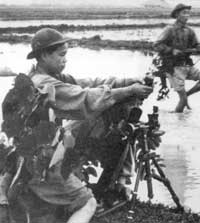
VC Mortar Team firing what appears
to be
a Type 63 60mm Mortar (note square baseplate)
The Type 63 was really an updated version of the Type 31, with emphasis on portability for use in irregular and guerrilla warfare. It was much lighter in the firing position at 12.3 kg (27 lb) and had the same range as the Type 31. The basic features were the same except that there were angle plates at the rear corners of the baseplate for bedding in, rather than a rectangular spade. The Type 63 had one recoil cylinder, where the Type 31 had two. The weapon folded together for carriage, with the baseplate and bipod being placed under the barrel. Using the carrying handle on the top of the barrel, one man could easily carry it in rough country with the Number 2 mortarman carrying the ammunition. A consequence of this was that the mortar could be set up, sighted and ready to fire in a very short time. It had a slightly slower rate of fire at 15-20 rpm compared with 20-30 rpm for the Type 31 and M2, Its barrel length was also slightly shorter at 610 mm (24 in) as opposed to 675 mm (26.6 in) for the Type 31 and 726 mm (28.6 in) for the M2. All these mortars fired HE rounds, but the M2 also had an illuminating bomb, the M83.
|
|
The Soviet light mortars (M38, M39, M40 and M41) were of 50 mm caliber. The M41 50 mm did away with the bipod and shock absorber of the earlier models and used a supporting yoke which was mounted on the baseplate for elevation, traverse and cross level. Gases from the firing were ducted away from a gas regulator by a pipe under the barrel. This system was used utilised for range adjustment by rotating a sleeve in the base of the mortar which opened or closed a number of gas ports. To extend the range, the ports were all opened and to achieve the minimum range the ports were all closed. Its firing weight was 10 kg (22 lb) and it had a barrel length of nearly 600 mm (23.6 in). It fired HE rounds only and had a range of 800 m (875 yd).
MEDIUM MORTARS: 82mm mortar (CHICOM Type 20 and Type 53, Soviet M1936, M1937, M1941 and M1943)
Whilst the 82mm mortar was the standard caliber for communist forces the PRC and North Vietnam did produce 81 mm mortars mostly as copies of the American M1, with the PRC manufacturing 81mm fragmentation projectiles based on the American M43A1 ammunition. 82mm mortars (classified as 'medium' mortars) proved very popular as they combined high portability with firepower. Apart from the North Vietnamese copy of the M1, 82mm weapons in use were the Chicom Types 20 and 53 and the Soviet M36, M37, M37 New, M41 and M43.
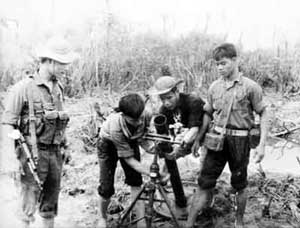
Viet Cong 82mm Mortar being set up
for firing
There was little variation between these types, although the PRC (and some of the older Soviet models) fitted wheels to the ends of the bipod legs. The weapon could then be towed from the muzzle. These wheeled versions had disadvantages in stability and maintaining cross level when firing, and the Soviets abandoned the idea with the M37 New. Although the Communists' weapons were usually 82 mm, they could fire NATO 81 mm rounds. This adaptability did not apply in reverse. The Communist weapons were automatic drop fired and had quite sophisticated aiming devices attached to the barrel about half-way up its length. Some used square or rectangular baseplates (M36 and M1 North Vietnamese copy), but most had circular ones. They all used a Brandt-type bipod with elevating screws and traversing gear at the top. They all weighed around 57 kg (114 lb) and had a barrel length of about 1,200 mm (1.31yd). The rates of fire were between 15 and 25 rpm. The ranges were at a minimum about 100 m (109 yd) and at maximum approximately 3,000 m (3,281 yd). The bombs were impact detonated and weighed about 3 kg (6.61b) each. They were of HE and smoke natures. The Vietnamese developed a chemical delay fuze, which was activated on impact and delayed the explosion. This was used with HE and fragmentation rounds. The M1 copy was popular with the VC because it could be broken down into three one-man loads.
|
|
|
With a range of over two miles, the 82mm mortar could be considered as an ideal standoff weapon. However, weighing over 100-lbs when fully assembled, when used for standoff attacks, the crew would have to drop the rounds in rapidly and then move since counter-battery fire by US aircraft was too effective and it took time to break the mortar down into three or four carrying loads. For this reason the medium mortars were often used from established positions and the mortar either camouflaged or dismantled and hidden after use.
This was a conventional muzzle-loaded, drop-fired, smoothbore weapon. The M1937 consisted of three basic components: tube, bipod, and baseplate. The recognizable features of this mortar were the baseplate, which is circular with a flat surface across the back edge, and the bipod, which has a turnbuckle type of cross-leveling mechanism between the right leg and the elevating screw housing.
HEAVY MORTARS: 107mm (Soviet M107 and M38); 120mm (Soviet M1938 and M1943, Chicom Type 55); 160mm (Soviet M1943)
Heavy mortars, of calibers above 100 mm, were not much used by the VC as they were not as portable as medium and light mortars, but they were used by the NVA. They were all moved on a two-wheeled carriage. The USSR had weapons of 107mm (the M107/M38), two designs of 120mm (M38 and M43) and one of 160 mm (M43). The PRC Type 55 120 mm was a version of the Soviet M43. The M38 107 mm was a scaled-down version of the M38 120 mm for use by Mountain Divisions. Both could be broken down into three loads for animal pack transport, or could be moved complete on their two-wheeled carriages, towed behind any suitable vehicle. The 107mm M38 has a five-man crew, and the M107 a six-man crew. All these types could be drop fired (automatic) on to a protruding firing pin, or manually fired using a trigger device and lanyard. With the exception of the M43 160 mm they were all muzzle loaded. The 160 mm mortar was breech loaded and as a result could only be fired by lanyard and trigger. The barrel was swung upwards from the base, being pivoted on trunnions located not far from its center point. The bomb was inserted and the breech closed. The barrel was then swung back down to the firing position. The shock from firing was absorbed by shock absorbers and a disc-shaped baseplate.
All these weapons had surprisingly short ranges when compared with NATO mortars: The M43 160mm had a maximum range of 5,150 m (5,645 yd) and a minimum of 630 m (689 yd); the M43/Type 55 120 mm had a range of 5,700 m (6,234 yd) maximum and 460 m (503 yd) minimum; M38 120 mm had the same ranges as the M43 120mm; and the M38/M107 107mm mortars had a maximum range of 6,300m (6,890yd) and a minimum of 800m (875 yd). The minimum ranges made for problems of sighting in the close country of Vietnam, and the maximum ranges left a lot to be desired - nevertheless the NVA did spectacular damage with these weapons.
107mm mortar (Soviet M107)
This mortar was a scaled down version of the 120mm M1938, reduced in weight and size to suit its normal role as the regimental mortar of mountain units in the Soviet army. Ideally suited to the NVA and VC operating in difficult terrain, the mortar could be broken down into barrel, bipod and base-plate for man-packing or else folded together for towing on a two-wheeled carriage.
120mm mortar (Soviet M1938, M1943 and CHICOM type 55)
The M1943 replaced the earlier M1938 which, when first developed, had a unique design: it consisted of four components (tube, base-plate, bipod and carriage) that could be quickly broken down for movement over short distances. For normal travel the whole weapon folded together and could be towed on its two-wheeled carriage or, if necessary man-packed in it's four component parts.
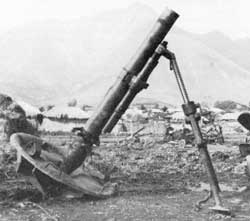
Soviet 120mm Mortar M1943
The only differences between the two weapons are that the newer M1943 had much longer shock absorber cylinders and the elevating and traversing gear was more sophisticated. Apart from these changes, the ballistic and performance details, as well as the methods of handling, remained the same.
The Chicom Type 55 was a direct copy of the Soviet M1943.
This was a conventional, muzzle-loaded, smoothbore mortar that could be either drop-fired or trigger-fired. An anti-double-loading device could be attached to the muzzle.
|
|
|

A standoff attack has been defined as an attack using 'a weapon launched at a distance sufficient to allow the attacking personnel to evade defensive fire from the target area'. The prime requisite of standoff weaponry is superior mobility. Whilst the NVA were very aware of the importance of fire support, their particular war of mobility forced them to travel light and despite all the differences in weapon characteristics, all NVA/VC mortar, recoilless rifle, and rocket units shared one key attribute – superior mobility. The weapons themselves and the ammunition could be man-packed to just about any launch location.
The NVA/VC considered US and Government of Vietnam (GVN) military installations as being both vulnerable and lucrative targets and that standoff attacks against these installations allowed them to accomplish the following objectives:
· Destroy valuable US and GVN military combat assets.
· Demonstrate their capability to attack and inflict damage on major US and GVN military establishments at a time and place of their choosing.
· Cause the US and GVN to use a considerable portion of their military capability to protect military installations.
· Weaken the morale of military personnel located on these installations.
This philosophy was supported to some extent by a prisoner of war, a rocket company commander, who made the following statement while being interrogated in 1968:
US forces in Vietnam are disposed in large fixed installations which always provide our forces with lucrative targets. Our forces are always certain that as long as the weapons hit the installation, the US forces will lose equipment and manpower. Likewise, these large posts do not have sufficient forces to control the surrounding countryside, which makes our attacks easier....
There were a number of weapons in the NVA arsenal that met both the definition and fitted the philosophy of standoff attacks:
Recoilless rifles, whilst effective, were nonetheless extremely vulnerable and could not properly evade defensive fire unless only a few rounds were fired and the crew dismantled the position rapidly.
Mortars, particularly the heavier 81/82mm with their greater range, were were generally pre-sited in emplacements and aimed at specific targets which were generally not mobile (e.g. base camps, airfields etc). Ammunition was brought in by a crew and rapidly fired. The crew then hid the mortar and fled on foot. In many cases, mortars employed in this role were often spotted by allied aircraft and destroyed in-situ before having fired off their basic load. The smaller, 60mm mortar, was much more suited to the role of standoff attack and met the 'high mobility' definition.
In the fight against the French in the First Indochina War, pack howitzers had played a decisive role. In the war against the Americans however, pack howitzers could only be used in areas where US airpower could not strike within forty minutes and by 1966 there was nowhere in South Vietnam that met this criteria. As US airpower became increasingly pervasive these weapons, that had to be transported by pack animals, disappeared from the battlefield. Besides, the Chicom 70mm howitzer weighed nearly four times as much as the 81/82mm mortar, had less explosive power and about the same range. It was not therefore an adequate standoff weapon.
The overwhelming presence of US airpower also meant that heavier mortars and artillery were generally not sited for use in South Vietnam but rather fired from Laos, Cambodia or North Vietnam.
Over time, the most effective standoff weapons proved to be man-transportable rockets.
Regimental and Battalion Weapons
Mortar, recoilless rifle and heavy machine gun companies were organic to infantry combat support regiments and were employed at all echelons as combat support units. A typical infantry combat support regiment was assigned an 82mm mortar company, a 12.7mm heavy machine gun company and a 57/75mm recoilless rifle company. Each of these companies was officially authorized six weapons and approximately 80 personnel although these numbers were often exceeded. These companies were supported as required by one signal and one reconnaissance company organic to the regiment. The subordinate battalions were also armed with 60mm mortars, some 81/82mm mortars and a few 57mm recoilless rifles.
Mortars and Recoilless Rifles were employed as separate standoff attack forces, as a composite force, or in conjunction with rocket standoff attacks.
When employed as individual weapons systems, care was exercised to position these weapons in a relatively well concealed area. They were known to have been positioned within hamlets, at the edge of small villages, in churchyards or in close proximity to individual dwellings. The capability of allied counterfire appears to have been the key to their method of employment.
When employed in conjunction with rocket standoff attacks, where no attempt to breech the installation defenses was planned, mortar and recoilless rifles were normally employed as follow-on fire to the initial rocket attack. When used in this manner, they were normally employed as cover fire while the rocket force withdraws. The recoilless rifle unit was usually the last to withdraw.
A prisoner of war interrogated in December 1963 stated that recoilless rifles and mortars were more accurate than rockets and therefore could be used against smaller targets. He stated that except for the difference in range, they were used in a fashion similar to rockets.
Standoff Rocket Bombardment
By 1966, rockets began to dominate over mortars as the NVA's standoff weapons of choice. Their light-weight, salvo fire capability, and increased explosive power, meant they could be more flexibly employed and substantially increased the standoff threat. This threat was further enhanced by the fact that the standoff range of the 120mm mortar, 5,700-meters, was doubled by the range of the 122mm rocket, 11,000-meters.
Rocket Units were organized into regiments, battalions, companies and platoons. Each regiment was assigned a headquarters squadron, a signal and reconnaissance company and three rocket battalions. Within a typical rocket battalion there was a headquarters company and three rocket companies. Each 122mm rocket company was authorized six launchers and 18 rockets. The 107mm rocket company was normally authorized 12 launchers and 24 rockets. The 140mm rocket company was normally authorized 16 launchers and 16 rockets. All rockets could be employed from improvised launchers. When employed in large-scale standoff attacks, rocket units were often supported by elements of an infantry combat support regiment.
It was usual for mortar and recoilless rifle units to operate separately from rocket units, but sometimes they worked together in varying combinations. If they were used as part of the same standoff attack, they were fired sequentially in the order; rockets, mortars, recoilless rifles, RPGs and MGs.
In support of direct attacks against allied positions, rockets and mortars were used to fire on area targets such as ammo dumps, aircraft parking areas, fuel dumps and troop cantonments. The recoilless rifles and other direct firing weapons would hit point targets such as bunkers, weapons positions and command and communications centers.
Reconnaissance
Prior to a standoff attack, and in keeping with the NVA practice of thorough preparation, the NVA would conducts a thorough reconnaissance of the installation.
Each installation to be attacked was normally reconnoitered at least three times before the attack. The reconnaissance element normally consisted of three teams of three individuals each. Intelligence agents and recon units would scrutinize the target and visit it several times. Reconnaissance entailed a detailed analysis of the installation proper to determine the location and disposition of critical equipment and facilities, the location and manning of command posts, the number and type of perimeter and internal defense positions, and the schedule of installation operational activities. Efforts of the reconnaissance element were often supplemented by enemy agents (male and female) located on and off the installation.
After studying the reports by the reconnaissance element, final reconnaissance of the target was normally conducted by the rocket force company commander prior to making final decisions and preparation for attack.
In order to maintain maximum security, it was normal for the the launch crews not to be informed of any details regarding the operation ahead of time. They were guided to the sites unaware of the exact time of the attack or location of the launch site.
Point targets within the target area were precisely identified and individual standoff weapons resources were allocated to it. After that, an operational plan was drawn up which included the date and time each of the following actions was to occur:
Weapons Site Preparation.
|
|
Rocket accuracy depended on precise firing data calculations utilizing such instruments as theodolites and transits. Prior to each rocket attack, a survey team arrived and conducted a survey of the launch site to establish and align each rocket launch position. The survey team decided on the position, azimuth direction and firing elevation of every launcher or rocket. They also decided which launching mode, whether ramps, pits or improvised stick tripods was necessary. This survey was usually conducted the afternoon before the attack and as the survey progressed, aiming stakes were placed on and in the ground to serve as a reference for positioning, aligning and aiming each rocket or rocket launcher. Following the preparation of the site, rocket launch crews arrived at the launch site after dark. Armed with tools such as picks, shovels and machetes, they would cut a trail from the rocket storage point to the launch sites and take an inventory of the hidden rockets. |
Using the reference stakes placed by the survey team, the launch crews positioned and aligned the rocket or rocket launchers and double checked against survey party calculations. The rocket launcher firing pits were prepared and dug out and the rocket launch systems were wired for firing. Once all of these preparations was completed, the rockets were finally loaded into position.
Rockets were grouped into firing batteries of six rockets and located twenty meters from the other rocket groups. Within each firing battery, rockets were individually spaced ten meters apart. Total time to prepare rocket launch positions, after arrival of the rocket launch crews, varied from 20 minutes to an hour, dependent upon the size of the force and the type of launchers being used.
Employment of mortar and recoilless rifles required preparations similar to those required to fire rockets, except the aiming stakes were normally 20 to 30 meters in front of the firing position. Weapons positions were normally established in a semicircular pattern with the smaller caliber mortars forward of the larger caliber mortars and the recoilless rifles on the flank of the larger caliber mortars. Mortars were usually positioned in a circular foxhole 1.7 meters deep and two meters wide with a dirt bank around the position. This position was usually camouflaged with branches, grass or other like material. Recoilless rifle positions were usually located on high points offering concealment.
Weapons Movement.
Weapons were transported from the resupply point to the staging area by sampan, foot, or both, using military transportation personnel and/or civilian porters. Movement from the staging area to the launch site was accomplished, with few exceptions, at night and by foot. The staging or assembly area was seldom more than one and one-half hours travel time from the launch site and in some cases, was as close as three to five hundred meters to the launch site. Movement of the 122mm rocket is best illustrated by excerpts from an account given by a prisoner of war captured on 25 June 1968 who had participated in numerous 122mm rocket attacks against military installations. As related by the prisoner..
... two personnel carried the launcher tube. This tube could not be broken down, so it was carried by one man on each end. The unit had discarded the tripod because of the weight and the fact that it took two personnel to carry it. By not having to transport the tripod, these individuals could be utilized to carry the rocket. Instead of the tripod, pieces of wood nailed together in the form of a "X" or "H" were used as a launcher tube cradle. It took two personnel to carry a rocket. One person carried the main body and another the warhead and fuse....
This same POW stated that he did not know how the rockets were transported to the resupply or staging location. However, other prisoner of war reports reflected that rockets were transported to staging areas or resupply points by a combination of military and civilian porters or by a combination of sampans and porters. These movements were conducted in daylight under cover of heavy foliage. If insufficient foliage cover existed then the movements would be conducted at night.
Staging areas were normally within one to two hours foot or sampan travel from the launch site. Exceptions to this were mortar units which supported battalion size operations involving a combination of standoff and sapper attacks on an installation. These movements were usually by foot and required up to two hours travel time from the staging area, dependent upon the distance to the launch site. However, in some cases weapons would be located adjacent to the launch site itself.
From five to 30 days preceding an attack, the NVA normally attempted to locate his weapons approximately three to five kilometers from the launch site. In some cases, these storage points were used as assembly or staging areas which are normally one to one and a half hours travel time from the launch site. In other cases, these storage areas may be located along river or stream banks adjacent to the launch site, in graveyards, abandoned villages or hamlets, astride boundary lines between US, RVNAF or FWMAF field units, in tunnels, or adjacent to or within inhabited areas, dependent upon the attitude of the civilian populace. In each case, maximum effort was made to conceal these locations by natural foliage or similar methods.
In his book 'Lima-6, A Marine Company Commander in Vietnam', R D Camp describes how his Marine rifle company discovered a rocket launching site near Khe Sahn:
About twenty meters in front of us, in a lightly wooded area on the side of the hill we had been approaching, were a dozen or so long black objects, right out in the open. Each was about seven feet long and about fifteen inches in diameter. They were obviously 122mm rocket launchers. Beside each launcher was a line of long stakes with vines wound around them. It was easy to see the NVA rocketmen could erect the stakes and vines as bipods to support the rocket tubes at angles from which the rockets could strike the Khe Sahn Combat Base, which was directly at our backs, though miles away. We found three 122mm rocket warheads, aiming stakes, fuses, and fuse boxes in among the launchers, each with Chinese markings. It was difficult to tell if the rocket site had ever been used, for we found no telltale burn marks from rocket ignitions. However, bark had been burned from several of the trees, so it was possible that the site had been used. The launchers were manufactured, of course, but they were stabilized on bipods constructed of wooden poles cut in the forest, pounded into the ground, and tied off with jungle vines. Neat!
Attacks by rockets usually lasted from two to twenty minutes dependent upon the size of the attacking force, the number of rounds available, and opposing counterfire response capability and accuracy.
If counter-fire reaction was slow, fire adjustment was made after the first two or three registration rounds. Forward observers, near the target area, called in launch data corrections to the rocket commanders by radio or field telephone.
NVA rocket units were organized into regiments, all of whose rockets could be fired from improvised launchers. Each regiment contained a headquarters company, a signal and reconnaissance company and three rocket battalions. Each rocket battalion included a headquarters company and three rocket companies.
|
|
The NVA normally employed rockets in salvos of three, six, twelve, and eighteen. On occasion, in the case of the 122mm and 140rnm rocket, as many as two battalions of eighteen rockets each were employed. A 122mm rocket battalion was equipped with three rocket batteries (one battery per company), each of which had six launchers or a capability of the battalion to launch 18 rockets in one salvo. In the case of the 107mm rocket, this capability varied from one to twelve rockets from each salvo, dependent upon the launcher used, the number of units, and the availability of rockets. The 140mm rocket could be launched from launcher tubes mounted on dirt pads or from improvised dirt and mud mounds. The number of rockets that could be launched was dependent upon availability of rockets, firing system and size of the launch site. |
In an attack against Da Nang Airbase in February 1967, one hundred and thirty 140mm rocket launchers were emplaced at a single launch site. Because of malfunctions in the firing system and individual rocket motors, only 66 were successfully launched of which fifty-six impacted on Da Nang Air Base and eight hit an adjacent village. The other two fell harmlessly outside of the target area.
In large standoff attacks, infantry weapons units protected the rocket sites. The potential reaction time and firepower of allied counter action by fixed-wing aircraft, helicopters, and artillery determined how long rocket attacks lasted. However, rocket attacks usually lasted two to twenty minutes depending on the availability of antiaircraft protection for the launch sites, the size of the assault force and ammunition availability. As the war progressed, rocket attacks increased in both ferocity and duration.
As a result of the increasing success of allied countermeasures, the NVA began to use new tactics for standoff attacks by attacking military installations from more than one launch site location, either simultaneously or by alternating salvos, in an attempt to increase the problem of counterfires. The reasoning behind these tactics was probably explained best by the captured rocket company commander, interrogated in December 1968, when he stated:
...The primary problem for our forces is air observation by the US followed by quick reaction air strikes (helicopter or fixed wing). This limits the number of rounds that can he fired on an installation. The rocket exhaust is visible for nearly 300 meters from point of ignition to point of burnout. This provides air observers with easily recognizable pinpoint locations of the launch site. Consequently, we have adapted hit and run tactics in accordance with the principles or guerrilla warfare. No more than five rounds are fired from any single tripod type launcher. This takes about 20 minutes. No more than two salvos are fired from homemade launchers, which takes about ten minutes. Displacement only involves the immediate pick-up of all equipment and leaving the area with all possible speed, which takes about five minutes....
NVA rocket troops soon learned that they had to follow these 'rocket raid rules' if they were to survive.
Withdrawal
Withdrawal from the launch site was planned in advance. The withdrawal routes for rocket units were planned to provide for concealment by the most direct route to the assembly or staging area. This route was normally the same as that used to reach the site. At night, emphasis was placed on speed. When a large rocket force was employed and its units were pursued, mortars would be used to give fire support during the withdrawal.

Characteristics of NVA and VC Recoilless Rifles
Recoilless rifles were usually employed to fire from the flanks of NVA units or from high points offering concealment and longer fields of fire.
57mm Recoilless Rifle (CHICOM Type 36)
The recoilless rifle that had the best mobility was also the lightest, the 57mm. The 57mm recoilless rifle weighed about 52-lbs and could be fired from the shoulder or affixed to a machine gun tripod for greater accuracy. Maximum effective range was about 1500 yards and it could destroy point targets although it had little effect on armored fighting vehicles. The Type 36 was a copy of the US 57mm M18 recoilless rifle.
This weapon could be fired from the shoulder, from its monopod, or from a tripod. The outstanding identifying feature of this weapon was the long, cylindrical monopod below the telescopic sight, the two protruding handles at the breech end, and the peculiarly shaped tripod.

ChiCom Type 36
75mm recoilless rifle (CHICOM Type 52/56)
Particularly favoured by the NVA and VC, the Type 52 combined firepower with light weight and could fire both PRC (Chicom) and US ammunition. This weapon was frequently used in attacks on fire bases and other strong-points. This was a breech-loading, portable weapon, designed to be fired from a machine gun tripod. The barrel and breech of the 52/56 weapon were copied from those of the US 3.5inch M20 rocket launcher.
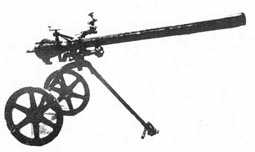
Chicom Type 54/56
The longer ranged 75mm RR weighed about 130-lbs and had to be carried by two or more crew. It fired high explosive rounds to a maximum range of 7300 yards and HEAT shells to an effective range of 875 yards. The long dismantling time and heavy weight of the weapon made using it in standoff attacks involved exposing the crew to a lot of risk from return fire or air attack. However, it was a very effective anti tank weapon.
Soviet B-10 (RG82) 82mm recoilless gun
Used by the Viet Cong, the B10 was a smoothbore, breech-loaded and percussion-fired gun mounted on a tripod-supported pedestal. The trigger and bolt being accommodated in a pistol-grip located above and to the right of the tripod mount, whilst the optical sight is on the opposite side in front of a rectangular, perforated guard. The gun was designed to be transported in a truck or armoured personnel carrier, but can be towed by its four-man crew on its small two-wheeled carriage using the conspicuous tow-bar fitted below the muzzle. The small castor wheel below the tow-bar is designed to prevent the muzzle touching the ground while the gun is being maneuvered or set up for firing on the tripod. The latter can be adjusted to give either a low silhouette or a better field of view, but the weapon can, if necessary, also be fired whilst still on the wheeled mount. A rate of fire of 6-7 rpm is attributed to the B10.
Recognition features were the two-piece tube, the detachable wheels, the multi-perforated guard on the left side, and the towing handle.
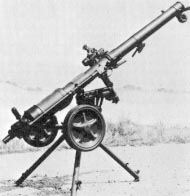
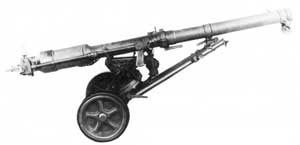
Soviet B10
Czech T-21 (Tarasnice) 82mm recoilless gun
The Czech T21 recoilless anti-tank gun was a very versatile weapon, capable of being fired from its small two-wheel carriage, from the shoulder or from a fixed mount.
It was a smooth-bore weapon, firing a shaped-charge fin-stabilised HEAT round, which is breech-loaded, and fired electrically - as with the P27 anti-tank grenade launcher, the trigger action works a magneto. To cope with the direct and indirect fire capability, the T21 was equipped with ordinary iron sights graduated in 50m intervals and also a telescopic sight graduated at 100 m intervals.
The HEAT round, 2.1 kg in weight, could penetrate up to 230mm of armour at an effective range of 300m if the target was moving, and up to 650m if the target was stationary. Rate of fire was about 5rpm, but this was adversely affected by the absence of a used round extractor in the breech, which had to be cleared manually with the aid of an asbestos glove.
The T21 was usually transported in a truck or armoured personnel carrier, but could be towed for short distances using the long tubular towing handle, normally kept folded over the top of the tube.
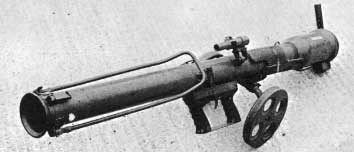
Czech T-21 Tarasnice 82mm
Soviet B-11 (RG107) 107mm recoilless gun
Use by both the NVA and VC, the B11 (or RG107) was the biggest recoilless gun manufactured by the USSR, having been developed (along with the B10) from knowledge gained from United States weapons captured during the Korean War.
Whilst the B11 was designed primarily as an anti-tank gun, able to pierce 350mm of armour at 450m, it was light and mobile enough on its two-wheeled carriage to be maneuvered in battle by its five-man crew using the light tow-bar attached below the muzzle. Although the B11 can, like the smaller but similar B10, be fired from its wheeled mount, the motor-car-type wheels were awkward and were often removed whilst the gun was raised on its tripod.
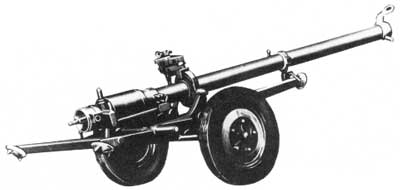
Soviet B11
The two main recognition features of this weapon were the tripod which, while traveling, was spread with the front leg attached to the tube and the two rear legs raised and carried at an angle to the rear, and the limber loop above the muzzle by which the gun was connected to its towing truck.
The B11 is breech-loaded, using a shaped-charge, fin-stabilised HEAT or HE round. The PBO4 direct and indirect fire sight was mounted high and centrally on the gimbal mounting of the barrel.
NVA Regimental Recoilless Rifle Company
· 100 men divided into 3 platoons and 9 squads, containing 6 x 75mm RR and 3 x 57mm RR; or 9 x 75mm RR or 57mm RRs. 75mm RR squads contained 10 men, 57mm squads contained 6 men.

Characteristics of NVA and VC Rockets
INTRODUCTION
The Soviet enthusiasm for multiple rocket launchers (MRLs) was not lost on the NVA and VC who readily employed rockets in the standoff role for which they were ideally suited. However, whereas Soviet systems were fully motorised, because of US fire superiority the NVA and VC had to rely almost entirely on man-packed single rocket and launcher tubes.
The Vietnamese Communists used three types of artillery rocket; the 140mm BM14-16 and the 122mm BM21 came from the USSR and the 107mm Type 63 from the PRC.
The BM14-16 was mounted on a ZIL-151 or ZIL-131 6 x 6 truck and the BM21 on a Ural-375D 6 x 6, although both could be mounted on any suitable vehicle - even American ones. The Type 63 was mounted on a rubber-tired split-pole carriage which could be towed by any suitable vehicle, or even yoked animal transport. It could also be mounted on a 4 x 4 or 6 x 6 truck, and on the PRC K-63 APC which the NVA used. A special model for use by mountain and airborne troops was developed which weighed 281 kg (618 lb) in the firing position (as opposed to 602 kg (1,324 lb) for the standard model), and this was ideal for guerrilla use. It could be broken down into man-packable loads. It had three banks of four 107mm barrels mounted on the carriage. When in the firing position, the carriage's wheels were removed and the towing trails opened out into two legs to the rear. There were two further short legs in the front. The rockets were spin stabilized by the rifling in the barrels. The rockets could be fired from a single-round launcher as well as the 12-round assembly.
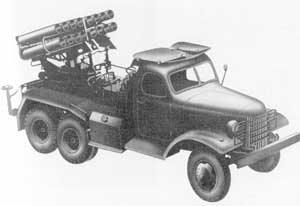
Soviet BM14 140mm MRL
The Soviet BM14-16 was a 16-round 140mm multiple-rocket system which first appeared in 1953. It was designed to be mounted on wheeled vehicles such as the ZIL-131 6 x 6 truck. It threw a 40 kg (88 lb) rocket to a range of about 6,000 m (6,562 yd), with a CEP (circular error probability - the average distance on impact that a projectile has deflected from its point of aim, some 50 per cent can be expected to land within the CEP) of 100 m (109 yd). Such CEPs made Soviet rocket systems almost into point attack weapons, rather than the area weapons that artillery systems normally are. The M14-OF rockets of the BM14 were spin stabilized by the rifling of the launcher barrels.
The 122mm BM21 was a 40-round system mounted on a Ural-375D 6 x 6 truck, although any suitable lorry could be used. The rockets were fin stabilized, and two types could be fired from the four banks of ten launcher tubes. There was a 1.9 m (2.1 yd) short rocket with a range of 11,000 m (12,030 yd), and a 3.23 m (3.53yd) long rocket with a range of 20,380 m (22,288yd).
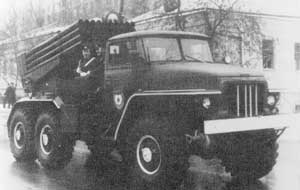
Soviet BM21 122mm MRL
The DKZ-B anti-building and anti-personnel free-flight rocket launcher was, in fact, a single tube from a BM21 with a tripod mount especially intended for use by guerrilla-type forces- this too was used by the NVA and VC. It broke down into two loads., the 2,460 mm (96.9 in) long, 22 kg (48.4 lb) tube and the 28 kg (61.6 lb) tripod mount. It had a range of 10,900 m (1 1,920 yd) and fired a 46 kg (1 01.2 lb), 122 mm rocket measuring 1,905 mm (75 in) in length. It was both f in stabilized and spin stabilized by the rifled tube. The mount had a panoramic sight and fitted quadrant. The missile could be set to impact detonation or delayed-action detonation.
The DKZ-B single-rocket system used the short rocket. The short rocket could also be fitted with an additional motor to reach a range of 17,000 m (18,591 yd). The warhead types used included smoke, chemical, and HE-fragmentation. In Vietnam, the NVA used the HE-fragmentation type to attack FW positions. These systems appeared briefly during the 1968 Tet Offensive, later during the 1972 Easter Offensive, and again in 1975.
107mm Rocket (CHICOM Type 63)
A spin-stabilized, barrage rocket of Chinese communist manufacture equipped with a high explosive, fragmentation warhead. This rocket was employed against both point and area targets. One man could easily transport the complete round, rocket and fuse. The lightest of the rockets, it could be introduced into otherwise inaccessible launch sites. The 107mm, with an effective range of 6-8 kilometers, could be fired from launch tubes, earth banks, bamboo frames or improvised crossed sticks.
The 107mm rocket was designed to replace the CHICOM 102mm rocket. It was slightly longer, had a longer warhead, greater range and was more accurate.
· Length with fuse - 33 inches
· Weight with fuse - 42 pounds
· Range - 6000 to 8000 meters
· Fuse - super quick, short delay, long delay
· Launcher weight - two tubes - 48.75 lbs, twelve tubes - 547.5 lbs
· Tube length - 35.42 inches.
An NVA training document, captured on 28 October 1968, indicated that firing pads for the 107mm rocket could be made of dirt, bamboo frames or crossed stakes. It further stated:
... We can use road embankments, a dike between two rice fields, the brim of a combat trench, an earth mound, a bomb crater or an ant hill, digging a semicircular hollow in which to fit the rocket....
The main purposes of the rockets are objectives having a large area, usually 400 x 400m, such as enemy strongholds, airfields, storage points or towns. Besides, it is also used to support the infantry and to attack distant objectives that may affect the combat mission of the infantry. Each cadre should not fire over 20 rockets at a time. The average number of rockets should be six to make command and control easier....
122mm Rocket (Soviet BM-21)
This Soviet rocket possessed the longest range, three to eleven kilometers, of any of the rockets fired at the allies and was used extensively by the NVA and VC. A fin stabilized weapon with more destructive power than any others, this rocket was lethal within a 163 square meter burst area. Although the use of launch tubes ensured greater accuracy, the 122mm could be fired from improvised launch sites with a range of three to eleven kilometers.
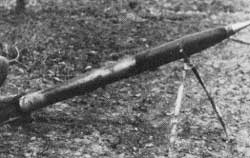
Soviet 122mm rocket (short version)
The 122mm rocket was fin stabilized and possessed a greater range and destructive power than either the 107mm or 140mm rocket. Without the need for a thick iron casing there can be more explosive and the 122mm rocket also has a greater punch than its equivalent 122mm howitzer shell.
· Length - 75.4 inches
· Weight - 101.86 lbs
· Range with spoiler ring - 3,000 to 7,000 meters. Without spoiler ring - 6,000 to 11,000 meters
· Warhead - 14.5 lbs explosive
· Launcher length - 8.1 feet
· Launcher weight with tripod - 121 lbs.
The first military installation in South Vietnam to be attacked by 122mm rockets was Camp Carroll in early March 1967. Following their initial use, these rockets were used not only against military installations, but also against urban areas, ports and bridges throughout South Vietnam.
Attacks by these rockets were usually of longer duration than attacks by 140mm rockets since more than one 122m rocket could be launched from the same launch position when using the rocket launcher. The 140mm rockets were usually launched from individual launch tubes positioned on dirt or mud launch pads. These tubes were seldom reloaded for follow-on attacks.
|
|
|
|
Artist Sketch of Soviet DKZ-B 122mm Rocket & Launcher |
Soviet DKZ-B 122mm Single Shot Launcher |
A 122mm rocket battalion was normally assigned three companies. Each company was authorized six launchers with three rockets each. POW reports indicated that attacks could be conducted by individual companies with 18 rockets, by a battalion with 54 rockets or, in rare cases, by a platoon with six rockets.
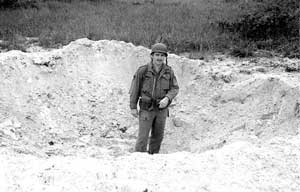
122mm rocket crater
Prisoner of war interrogation reports also indicated that a 122mm rocket launcher site could be set up and operational in approximately one hour and fifteen minutes. Preparation consisted of digging the fire pits and backblast pits, making the cradle for the launcher tube (in the event of the tripod not being used), connecting the firing system, and loading the rockets. In the event of a misfire, two additional attempts were made, time permitting, before the rocket was discarded.
140mm Rocket (Soviet BM-14)
With a lethal area of 140 square meters the Soviet 140 was more useful against material targets. Very easy to deploy, it could be fired from a board-mounted tube or earth mounds. With an effective range of one to ten kilometers, the fin-stabilized 140mm could be fired close to its target.
|
|
|
|
Soviet
140mm rocket components |
Soviet
140mm launcher and rocket. The launcher |
The 140mm rocket could be launched from single tubes mounted on a board or from earth mounds. Its greatest advantage was its ease of employment.
· Length with fuse - 42.3 inches
· Weight with fuse - 90 lbs
· Range - minimum - 1,000 meters, maximum - 10,000 meters
· Fuse - super quick, long delay - 1 second, short delay -.5 seconds
· Launcher tube length - 45 inches
· Tube weight - 22 lbs.
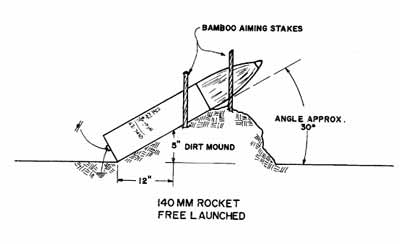
This rocket was employed extensively against all types of military installations. For the most part, attacks using these rockets were of short duration, usually lasting from one to two minutes. Reports indicated that launching positions were prepared after dark and more often than not, these rockets were launched from improvised dirt mounds. Launch mounds were prepared by digging shallow trenches or holes and piling the dirt forward to serve as a launch platform. Small aiming stakes were normally placed in front of the rockets to serve as an aiming reference. These stakes were positioned during daylight hours and, if discovered, were the best indicators of a potential 140mm rocket launch site.
GARBAGE CAN ROCKETS
Sometimes the NVA launched short range 107mm or 122mm rockets with oversized warheads containing twelve to ninety kilograms of explosive. "Garbage can" rockets were very inaccurate but they could be fired from earth mounds.
107mm CHICOM/VC Over-caliber Rocket
This rocket was a modification of the standard 107mm CHICOM rocket. Unlike the overcaliber 122mm rocket, its components were machined. Though its configuration reduced its accuracy, it was a relatively effective weapon at close range.
· Length - 54.25 inches
· Weight - 84 lbs
· Range - 1,500 to 2,000 meters
· Warhead - 27.75 lbs explosive
· Fuse - CHICOM type 1 in nose and DK 2 in base
· Launcher - improvised trough or dirt mound.
122mm Soviet/VC Over-caliber Rocket
This was a VC modification of the standard 122mm rocket. This rocket had great destructive power but because of its apparent ballistic deficiencies, it was relatively inaccurate and best suited for harassment purposes.
· Length 83 inches
· Weight 281 lbs
· Warhead 120 lbs explosive
· Fuse DKZ-B in nose
· Range 1,000 to 1,500 meters
· Launcher - improvised rail type.
122mm Over-caliber Rocket (Improved Version)
These rockets were first found in a cache complex on 9 February 1969, at XT 544719, 28 kilometers southeast of Katum, Vietnam.
· Length - 78 inches
· Weight - 182 lbs
· Warhead - 115 lbs HE, 82 lbs RDX explosive
· Range 800 to 2,500 meters
· This rocket was launched from a rail launcher.
107mm Over-caliber Rocket (Improved Version)
These rockets were found in the same cache complex as the 122mm rocket above.
· Length - 44 inches
· Weight - 73 lbs
· Warhead - 42 lbs HE, 27 lbs RDX explosive
· Range 700 to 2,000 meters
· This rocket was launched from a rail launcher.

Sapper Attack
It was 24 February, 1969; the day of the planned attack had arrived. The objective had been painstakingly reconnoitered; detailed sketches made of all installations; natural and man-made obstacles plotted; mortar concentrations laid in, checked and rechecked; attack signal, password and signals for rally point and withdrawal memorized by all hands. Every conceivable detail was worked out, down to and including sand table briefings and several rehearsals on terrain similar to that of the target area. All was in readiness.
The attack forces moved out from their base camps at 0730, and using previously reconned routes executed a covered approach to final assembly areas. At 1800 all attack groups were 100 meters from the concertina wire obstacles, which encircled the objective. The time between 1800 and 0200, 25 February, was spent crawling to positions, which were just outside the defensive wire. Promptly at 0200 the mortar sections commenced their accurate fires on previously selected primary targets within the enemy position. The defender's mortar positions, command bunker, communication bunkers and artillery positions were singled out for accurate and intense fires. As the rounds were tubed, they could be heard by the defenders, and the incoming mortars were amazingly accurate. Aside from the damage and noise and confusion caused by the increasing volume of mortar fire, the defenders were forced to go to their bunkers. All positions had been painstakingly constructed for just such an eventuality. All individual crew-served positions had been overheaded and bulwarked with at least four layers of sand bags. The outboard defensive positions, or those that were on the perimeter, were not subjected to the same firepower as the key installations previously mentioned. The majority of mortar fire was placed on the inboard positions. The volume of fire increased as the gunners laid on previously observed and selected positions. The defenders would later wonder about this particular point. Why had not the perimeter positions, including the first line of passive obstacles and strong fortifications, been subjected to the same accurate mortar concentrations? They had not been overlooked however, the rationale of the assaulting units was based on several very fundamental and essential military considerations.
First, the so-called "key installations" were given the major attention. That is, the Command Operations Center (COC - the nerve center of the entire base); the mortar positions of the defenders; the ammunition bunkers; the Fire Direction Center; and the artillery battery. The latter, of course, was the focus of the attention on the majority of the attacking elements; "hill top" artillery had proved to be one of the defender's key tactical innovations, and one which he had used consistently and with surprising success.
Secondly, the psychological factor of heavy volumes of fire being placed on key installations within the perimeter was a significant one. Personnel on the perimeter could see and hear these fires, and there were undoubtedly those who were wondering when their turn would come. It definitely contributed to a certain wariness and wonderment on their part.
Thirdly, under the cover of these fires, the assault elements made final preparations before breaching the fixed, defensive obstacles, rapidly penetrating all such outer defenses. And manifestly, fires placed on the perimeter positions would have interfered with such preparations and caused casualties to certain assault elements.
At 0215, as the mortar concentrations reached a crescendo, the assault groups commenced their efforts to breach the defensive obstacles. The initial assault wave came from the northeast and made liberal use of improvised bangalore torpedoes. These had been fashioned from ½-pound blocks of TNT, locked together in a row between bamboo sticks. The attack route lay trough one of the defender's trash pits. This proved to be an ingenious selection; there was a well-worn path from the dump to the defensive perimeter. The mortar fire on the defensive position was augmented by machine gun sections and rifle grenades. The dual effect of all these fires was a partial breaching of the defensive wire, and literally the deafening of a number of men on the defensive perimeter. A major contributing factor to the latter state was the fact that the artillery battery on this position had been firing missions for several hours in direct support of another defensive position approximately eight thousand meters to the northwest.
The primary attack was executed by three main groups. One was assigned the mission of assaulting and destroying the battery of facilities: Fire Direction Center, ammunition pits and the artillery pieces themselves. The second assault group was assigned the mission of assaulting and destroying the Command Operations Center and mortar positions. The third group was to converge on the landing zone and juncture with the other assault units to effect a mop-up. A fourth group was organized to function as an extraction force; this group was to assist in the withdrawal of those groups which assaulted the objective. The fifth group was the base of fire, which provided the supporting mortar, machine gun and rifle fires.
What have been described up to this point are the basic preparations and commencement of an actual NVA sapper attack on a Marine fire support base near the DMZ. A detailed examination, translation and analysis of documents found on the body of a sapper officer, within the perimeter, revealed the following organization of the primary assault elements:
GROUP 1
GROUP 2
GROUP 3
The planned entry points, directions of the attack of the major attack groups and their objectives are indicated in Figure 1.
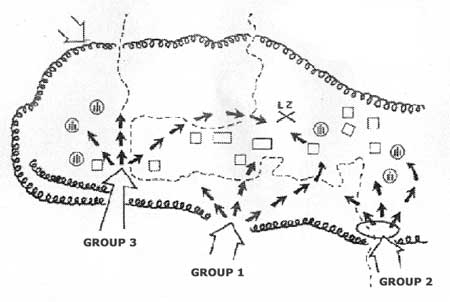
Figure 1: LZ Russell 24th February 1969
Another factor, which aided the attackers, was the reduced visibility of the
objective areas. In addition to being a period when there was very little
moonlight, a thin blanket of fog enveloped the entire defensive positions and
all the routes of ingress.
The attack continued until about 0530. At that time, the Marines on the fire support base reorganized themselves and slowly, but methodically killed virtually all the enemy sappers who had penetrated the position. There were innumerable incidents of uncommon valor as the battle ebbed and flowed.
The officer-in-charge of the firebase found himself partially buried under a caved in bunker and as he crawled out he found himself face to face with one of the attackers. The commander had a fragmentation grenade in his hand, but he was too close to use it in its primary role. Instead, he leaped on the NVA soldier and literally bludgeoned the shocked enemy soldier to death.
The company gunnery sergeant dispatched several of the sappers in deadly hand-to-hand combat by using his personal knife as the primary weapon. Marines from the 106mm section, who were originally manning a machine gun on the southeast fringes of the position, assaulted and killed six NVA soldiers who were attempting to organize a strong point inside the firebase.
During the period from 0410 to daylight, only one of the defender's mortars remained in action. However, the mortar squad stayed on the gun throughout, re-established radio communications with the CO and fired a total of 380 rounds.
As darkness gave way to the dawn, the defenders re-established complete control of the firebase. Throughout the fight, the company commander called for artillery fires to box in the positions. A curtain of steel was brought in around the position from the batteries located on mutually supporting firebases. These fires were instrumental in preventing enemy reinforcement, or possible exploitation, and at the same time rendered the withdrawal of sappers at daylight a difficult task.
As the grimy, gutty Marines mopped up the battered firebase, they found a total of 24 NVA bodies inside the wire. Reinforced patrols later in the day and the following day located one of the enemy assembly areas, which were strewn with bloody battle dressings. Many drag marks were visible. As daylight broke, the firebase resumed a normal posture. All the guns in the artillery battery (less one temporarily out of action) were manned and ready. The perimeter was reorganized and friendly casualties med-evaced. As the resupply helicopters flew into the firebase, the small American flag, flying on a makeshift staff, was visible for all to see.
There were, and are, many lessons to be learned from this classic sapper attack. But the appreciation of standard NVA sapper tactics is fundamental to any discussion of lessons learned and countermeasures. After the announcement of the sapper company mission, the reconnaissance commences. A period of three to seven days may be devoted to a detailed reconnoitering of the objective. The terrain is minutely analyzed, defensive patterns are studied, all routes are carefully viewed, enemy positions noted and plotted, obstacles sketched and estimates made of the time required to breach the position. In short, a detailed terrain analysis is made and terrain appreciation utilized in developing the plan of attack.
The period between the final reconnaissance and the commencement of the attack is allocated to briefings and rehearsals. Sand tables are prepared from sketches and each soldier is given precise instructions.
The attack itself is characterized by speed, firepower and shock. The movement to the objective area is initiated many hours prior to the assault phase. This phase is characterized, in many instances, by what Marines term "creeping and crawling". It is a basic assumption of the sappers that a majority of the defenders will be driven inside their bunkers by mortar fire. Once this takes place, the RPGs and automatic weapons (of support force) open up on firing slits and ports.
The skilled sapper deliberately selects the most difficult avenue of approach, or one which offers the best opportunity for unobserved approach. The use of the defender's trash dumps is an excellent example of such a tactic. As the mortar fires lift, RPGs, Chicom Grenades, satchel charges and bangalore torpedoes create the impression that the mortars are still firing. The assault itself is made with utmost speed, attempting to keep the majority of defenders in their bunkers. Mats, brush, or any local material are thrown across the wire and demolitions are used on particularly tough obstacles.
The primary objective of the sappers is to penetrate the defenses and inflict maximum casualties; destroy equipment, ordnance and installations, and withdraw. This type of attack is not designed to occupy a position or to seize and hold a prominent terrain feature.
The major weakness in the tactics of the sapper is the requirement for time. He must have time; time to reconnoiter, time to plan, and time to rehearse. This element, in turn, provides the force on the target list valuable time to prepare for such an attack. If the unit is unimaginative and unaggressive, its fate is preordained. On the other hand, professionalism, hard work and ingenuity can contribute to the development of installations, which not only slow, but also crush such sapper attacks.
What can be done?
The foregoing checklist is only illustrative of a few of the actions that must be taken to combat the sapper threat. Possible techniques and tactics are almost endless. The point is that complacency; boredom and routine must be avoided like the plague. If aggressiveness, ingenuity and professionalism are stressed, the sapper attack is doomed to failure - no matter how well planned, for in virtually any sapper attack, the sapper unit is outnumbered by his opponent.

![]()